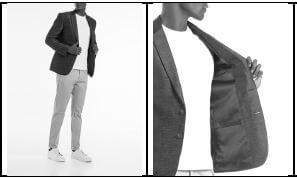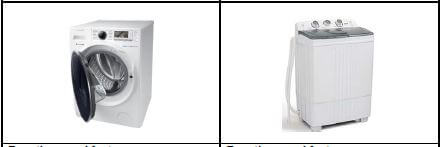Adele
CONSUMER STUDIES GRADE 12 QUESTIONS - AMENDED SENIOR CERTIFICATE EXAMS PAST PAPERS AND MEMOS MAY/JUNE 2018
SENIOR CERTIFICATE EXAMSCONSUMER STUDIES
GRADE 12
AMENDED SCE PAST PAPERS AND MEMOS
MAY/JUNE 2018
INSTRUCTIONS AND INFORMATION
1. This question paper consists of SIX questions.
QUESTION | CONTENT | MARKS | TIME (minutes) |
1 | Short Questions (All topics) | 40 | 20 |
2 | The Consumer | 20 | 20 |
3 | Food and Nutrition | 40 | 40 |
4 | Clothing | 20 | 20 |
5 | Housing | 40 | 40 |
6 | Entrepreneurship | 40 | 40 |
TOTAL: | 200 | 180 | |
2. ALL the questions are COMPULSORY and must be answered in the ANSWER BOOK.
3. Number the answers correctly according to the numbering system used in this question paper.
4. Start EACH question on a NEW page.
5. You may use a calculator.
6. Write only in black or blue ink.
7. Pay attention to spelling and sentence construction.
8. Write neatly and legibly.
QUESTIONS
QUESTION 1: SHORT QUESTIONS
1.1 Various options are provided as possible answers to the following questions. Choose the answer and write only the letter (A–D) next to the question numbers (1.1.1 to 1.1.20) in the ANSWER BOOK, e.g. 1.1.21 D.
1.1.1 Interest charged or paid on the principal capital plus the interest to date:
- Compound interest
- Fixed interest
- Prime interest
- Simple interest (1)
1.1.2 The type of vegetables that are exempted from VAT:
- Canned
- Dried
- Fresh
- Frozen (1)
1.1.3 A non-renewable form of energy:
- Hydro energy
- Coal
- Wind
- Solar (1)
1.1.4 The meaning of food security:
- Food is safe and hygienic
- Fruit and vegetables are produced organically
- Individuals have enough food every day
- People do not suffer from diet-related diseases (1)
1.1.5 The condition in which the arteries clog and narrow:
- Atherosclerosis
- High blood pressure
- Anaemia
- Hyperglycaemia (1)
1.1.6 A contagious viral disease that attacks the liver:
- Dysentery
- Gastro-enteritis
- Hepatitis A
- Tuberculosis (1)
1.1.7 … helps to maintain a healthy immune system as it keeps the linings of the lungs and intestine healthy.
- Vitamin A
- Protein
- Zinc
- Iron (1)
1.1.8 A consumer who wants to prevent osteoporosis but suffers from lactose intolerance, may drink …
- strawberry-flavoured milk.
- sour milk/amasi.
- cream soda flavoured milkshake.
- hot chocolate made with milk. (1)
Study the clothing items below and answer QUESTIONS 1.1.9 and 1.1.10. 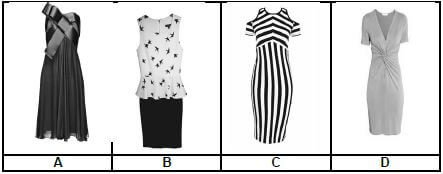
1.1.9 The clothing item that would be suitable for a lady with a big bust:
- Clothing item A
- Clothing item B
- Clothing item C
- Clothing item D (1)
1.1.10 The clothing item that puts the most emphasis on the waist:
- Clothing item A
- Clothing item B
- Clothing item C
- Clothing item D (1)
1.1.11 All building contractors should be registered with the … Council.
- National Home Builders' Protection
- National Home Builders' Registration
- National Home Builders' Regulation
- National Home Builders' Standardisation (1)
1.1.12 When a buyer of a property moves into the property before the bond is registered in his/her name, he or she is liable to pay …
- occupational rent.
- moving-in expenses.
- interim rent.
- initiation fees. (1)
1.1.13 The legal document that proves ownership of a property:
- Deed of sale
- Deed of registration
- Title deed
- Property owner deed (1)
1.1.14 Household appliances possess this feature so that any consumer can use it, regardless of prior knowledge, skills or abilities:
- Functional design
- Decorative design
- Ergonomic design
- Universal design (1)
1.1.15 A responsible consumer will … after buying a household appliance.
- compare appliances of different stores
- read the guarantee and contract carefully
- inspect the appliance for any defects
- read the store's return or exchange policy carefully (1)
1.1.16 One of the following represents the operational costs of a business:
- Rental deposit
- Initial equipment purchases
- Registration fees
- Water and electricity (1)
1.1.17 The 5 Ps of a business refer to the …
- marketing plan.
- marketing strategy.
- business plan.
- operational strategy. (1)
1.1.18 Production specifications help to … a product.
- standardise
- specify
- sustain
- select (1)
1.1.19 Calculate the selling price of ONE product if the production cost is R21,90 and the profit margin is 70%:
- R15,33
- R20,93
- R37,23
- R42,83 (1)
1.1.20 Peter's small-scale business now delivers products to his customers. This gives his business … over his competitors.
- break-even point
- larger target market
- different mark-up
- competitive edge (1)
1.2 Choose a description in COLUMN B that matches the food-related health condition in COLOMN A. Write only the letter (A–F) next to the question numbers (1.2.1 to 1.2.5) in the ANSWER BOOK, e.g. 1.2.6 G.
COLUMN A FOOD-RELATED HEALTH CONDITION | COLUMN B DESCRIPTION |
1.2.1 Anorexia |
|
1.3 Give ONE word/term for each of the descriptions below. Write only the word/term next to the question numbers (1.3.1 to 1.3.6) in the ANSWER BOOK.
1.3.1 A legal agreement between two or more parties (1)
1.3.2 Clears one party from any liability if he or she fails to honour the agreement (1)
1.3.3 An assurance that a product will remain in working order for a particular length of time (1)
1.3.4 Goods that have been imported into a country through unofficial or unauthorised distribution channels (1)
1.3.5 A community-based savings club (1)
1.3.6 Companies offer products for sale and salespeople receive a portion of the sales from a lower tier (1)
1.4 Identify THREE statements in the list below that are CORRECT regarding sectional title ownership. Write only the letters (A–H) next to the question number (1.4) in the ANSWER BOOK.
- Levy remains the same for many years
- Abides by the rules of the body corporate
- Have your own private recreational area
- Units can be sold for a profit
- Do not have to inform anyone about changes of ownership if a unit is sold
- Responsible for maintenance of the entire property
- Controls and manages the sectional title block
- Needs permission to make changes to the exterior of your unit (3)
1.5 Choose TWO characteristics from COLUMN B that match the stage in the fashion cycle in COLUMN A. Write only the letter (A–H) next to the question numbers (1.5.1 to 1.5.3) in the ANSWER BOOK, e.g. 1.5.4 I and J.
COLUMN A STAGE IN THE FASHION CYCLE | COLUMN B CHARACTERISTICS |
1.5.1 Launch 1.5.2 Peak 1.5.3 Obsolescence |
|
[40]
QUESTION 2: THE CONSUMER
2.1 State the beginning and end dates of a tax year. (1)
2.2 Name the institution that collects tax. (1)
2.3 Name the TWO types of direct income tax. (2)
2.4 Read the scenario below and answer the questions that follow.
David has just started working and has to pay back his study loan to the bank with fixed interest. He buys a bed on instalments and a television on lay-by. Inflation makes it more difficult to live within the limitations of his budget. |
2.4.1 Define the term inflation. (2)
2.4.2 Name the instrument that is used to determine the inflation rate. (1)
2.4.3 Explain why it is better for David to have a fixed interest instead of fluctuating interest on his study loan. (3)
2.4.4 Discuss why David bought the bed on an instalment sale transaction and the television on a lay-by agreement. (6)
2.5 Discuss the interrelationship between the value of money, inflation and the South African Reserve Bank. (4) [20]
QUESTION 3: FOOD AND NUTRITION
3.1. Answer the following questions on cholesterol.
3.1.1 Name TWO types of cholesterol. (2)
3.1.2 Explain the difference between the two types of cholesterol. (2 x 2) (4)
3.2 Write a paragraph to discuss why genetically modified crops may save the world from starvation in the future. (6)
3.3 Study the information below that appeared on the label of a macaroni cheese and bacon dish and answer the questions that follow.
MACARONI CHEESE AND BACON | |
Ingredients | Allergens
|
Typical nutritional information
Average values | Per 100 g serving | Per 300 g serving |
Energy (kJ) | 650 | 1 950 |
Protein (g) | 6,0 | 18,0 |
Carbohydrates (g) of which: Total sugar (g) | 18 0,0 | 53 0,0 |
Total fat of which: Saturated fat (g) Trans fat (g) Monounsaturated fat (g) Polyunsaturated fat (g) | 6,6 2,8 0,1 2,7 1,0 | 19,8 8,4 0,3 8,1 3,0 |
Cholesterol (mg) | 27 | 81 |
Dietary fibre (g) | 1,2 | 3,6 |
Total sodium (mg) | 380 | 1 140 |
3.3.1 Name THREE different types of additives in the dish. (3)
3.3.2 Give ONE concern about the use of sodium nitrite. (1)
3.3.3 Explain the function of sodium nitrite in this dish. (2)
3.3.4 Explain why cow's milk, wheat, gluten and egg are separately listed on the label. (2)
3.3.5 Identify the ingredient that has been treated with short waves to eliminate or reduce the number of pathogenic bacteria and other harmful organisms. (1)
3.3.6 Suggest TWO guidelines that must be followed by a consumer before eating this dish to prevent the transmission of food-borne diseases. (2)
3.3.7 Explain why this dish is suitable for the management of osteoporosis. (6)
3.3.8 Suggest a side dish to be served with this dish to make it more suitable for a consumer who has high blood cholesterol levels. (1)
3.3.9 Evaluate the suitability of this dish for a consumer who wants to manage obesity. (10) [40]
QUESTION 4: CLOTHING
4.1 Name TWO economic factors that have an influence on fashion change. (2)
4.2 Explain the term sustainable textiles. (3)
4.3 Discuss THREE guidelines for the choice of colour when selecting garments for a working wardrobe. (3)
4.4 Discuss the role of technology in fashion change. (5)
4.5 Study the photographs and information below and answer the questions that follow.
| This outfit consists of a navy blue jacket (50% cotton, 50% linen), white T-shirt, stone coloured cotton chinos/ trousers and white takkies/sneakers. [Source: www.woolworths.co.za] | |
4.5.1 State whether this outfit mainly represents fashion fads, fashion classics or contemporary fashion. (1)
4.5.2 Give TWO reasons for your answer to QUESTION 4.5.1. (2)
4.5.3 Suggest TWO suitable changes to this outfit to make it appropriate for a man with a professional job who is meeting new clients. Give a reason for each suggestion. (2 x 2) (4) [20]
QUESTION 5: HOUSING
5.1 Answer the following questions regarding a lease.
5.1.1 Define the term lease. (3)
5.1.2 Suggest THREE cost implications that should be included in a lease. (3)
5.2 Where is a title deed registered? (1)
5.3 Name FIVE ways in which an employer can support an employee in buying a house. (5)
5.4 Explain how paying a deposit influences EACH of the following when buying a property:
5.4.1 Bond registration fees (2)
5.4.2 Transfer fees (3)
5.5 Discuss why it may be better to buy a house than to build a house. (7)
5.6 Study the information below and answer the questions that follow.
A. FRONT-LOADER | B. TWIN TUB |
| |
Functions and features
| Functions and features
|
Compare the washing machines with specific reference to:
5.6.1 Washing capacity for a family of five members (2)
5.6.2 Human energy consumption (4)
5.6.3 Water consumption (2)
Tabulate your answer as follows:
FRONT LOADER | TWIN TUB | |
5.6.1 Washing capacity for a family of five members | (1) | (1) |
5.6.2 Human energy consumption | (2) | (2) |
5.6.3 Water consumption | (1) | (1) |
5.7 Read the information below and answer the question that follows.
There is an increased demand for rental properties in South Africa. [Source: Property 24, 31 August 2017] |
Validate this statement. (8) [40]
QUESTION 6: ENTREPRENEURSHIP
6.1 Define the term mark-up. (2)
6.2 State FOUR requirements of packaging. (4)
6.3 Name TWO components that determine the production cost of a product. (2)
6.4 Name FOUR ways in which producers can ensure that their products do not have a negative effect on the environment. (4)
6.5 Read the scenario below and answer the questions that follow.
Frieda worked at a curtain fabric shop for many years. Initially she did not know anything about fabrics or the measuring and sewing of curtains. She was paid a very poor salary. Over time she was trained informally by a colleague who was soon to retire. Frieda's salary increased slightly. She bought herself an industrial sewing machine with her savings and set up a functional sewing room in an empty bedroom in her house. The colleague started referring the shop's customers to Frieda for sewing curtains at home in her free time. Frieda charged the referred customers a slightly lower price for labour than the curtain shop. |
6.5.1 Frieda takes pride in producing quality products. Explain how she achieves quality products. (2)
6.5.2 Explain the best way to maintain the industrial sewing machine to ensure continued curtain production. (3)
6.5.3 Discuss the financial benefits for Frieda as she progressed from an unskilled worker to a skilled worker. (6)
6.5.4 Describe why Frieda's business has a competitive edge. (4)
6.5.5 Discuss the factors below that contributed to the success of Frieda's business:
- Availability of human skills (2)
- Availability of workspace (1)
- Consumer/Customer appeal (2)
6.5.6 Give valid reasons why Frieda's business can become a sustainable profitable business. (8) [40]
TOTAL: 200
DESIGN PAPER 1 GRADE 12 QUESTIONS - AMENDED SENIOR CERTIFICATE EXAMSPAST PAPERS AND MEMOS MAY/JUNE 2018
DESIGN
PAPER 1
GRADE 12
AMENDED SCE PAST PAPERS AND MEMOS
MAY/JUNE 2018
INSTRUCTIONS AND INFORMATION
- This question paper consists of SIX questions.
- There are three choice questions in this question paper. Read the options carefully.
- This question paper consists of THREE sections:
SECTION A: Design literacy (30 marks)
QUESTIONS 1 to 3
SECTION B: Design history (30 marks)
QUESTION 4
SECTION C: Design in a sociocultural/environmental and sustainable context (40 marks)
QUESTIONS 5 and 6 - Read the requirements of each question carefully.
- Answer in full sentences and avoid the listing of facts. Do NOT answer in tabular form.
- Use the mark allocation to determine the time to be spent on each question.
- Do NOT repeat the same facts and examples in different questions.
- Write neatly and legibly.
QUESTIONS
SECTION A: DESIGN LITERACY
QUESTION 1: 'UNSEEN' EXAMPLES
Answer EITHER QUESTION 1.1 OR QUESTION 1.2.
1.1 
FIGURE A: Bronze, Copper and Turquoise Pendant by Mike Edelman (Maryland, USA), 2016.
Discuss FIGURE A by referring to the following:
- Use of material(s)
- Possible inspiration(s)
- Form
- Focal point
- Colour (5 x 2) [10]
OR
1.2 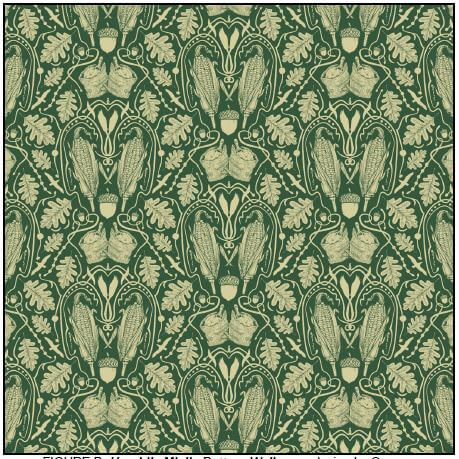
FIGURE B: Heraldic Mielie Pattern Wallpaper design by Quagga (South Africa), 2012.
Analyse the use of the following in FIGURE B above:
- Line
- Tone
- Subject matter
- Balance
- Rhythm (5 x 2) [10]
QUESTION 2: COMMUNICATION THROUGH DESIGN 
FIGURE C: Makarapa by Plan International (South Africa), 2015.
2.1 Identify THREE symbols in FIGURE C above and discuss their possible meanings. (6)
2.2 Explain the message of the poster in FIGURE C above with reference to the term cultural diversity. (4) [10]
QUESTION 3
Answer EITHER QUESTION 3.1 OR QUESTION 3.2.
3.1 Refer to FIGURE D and FIGURE E below and answer the questions that follow. 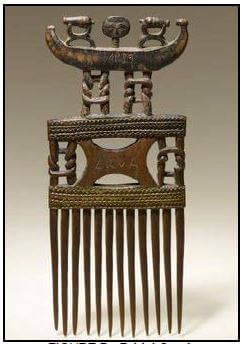
FIGURE D: Bridal Comb by Asante artist (Ghana), 1932. 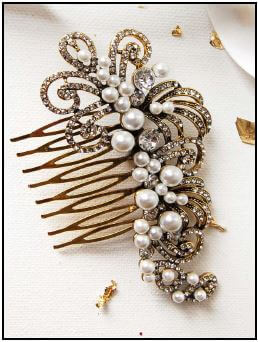
FIGURE E: Pearl Filigree Wedding Hair Comb by Highland Angel (Scotland), 2016.
Write an essay (at least ONE page) in which you compare FIGURE D with FIGURE E.
Refer to the following in your comparison:
- Possible influences
- Function
- Texture
- Pattern
- Materials (5 x 2) [10]
OR
3.2 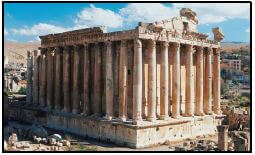
FIGURE F: Bacchus Temple, architect unknown (Baalbek, Lebanon), 3rd century CE. 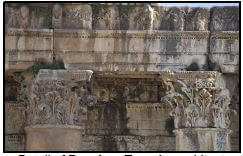
Detail of Bacchus Temple, architect unknown (Baalbek, Lebanon), 3rd century CE. 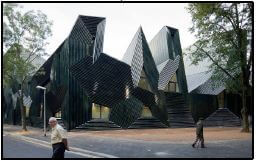
FIGURE G: Mainz Synagogue by Manuel Hertz Architects (Germany), 2010. 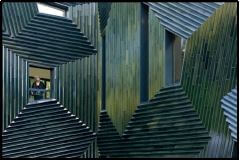
Detail of Mainz Synagogue by Manuel Hertz Architects (Germany), 2010.
Write an essay (at least ONE page) in which you compare the Classical temple in FIGURE F with the contemporary synagogue (Jewish place of worship|) in FIGURE G above. Alternatively, you may compare any Classical building with any contemporary building that you have studied.
Refer to the following in your comparison:
- Function
- Structure
- Building materials
- Influences
- Decorative elements or style of the buildings (5 x 2) [10]
TOTAL SECTION A: 30
SECTION B: DESIGN HISTORY QUESTION 4
4.1
To design is much more than simply to assemble, to order, or even to edit: it is to add value and meaning, to illuminate, to simplify, to clarify, to modify, to dignify, to dramatize, to persuade, and perhaps even to amuse. –Paul Rand |
Choose any TWO movements from the list below that reflect the quote above.
- Gothic
- Renaissance
- Baroque
- Neoclassicism
- Arts and Crafts
- Art Nouveau
- Bauhaus
- De Stijl
- Modernism
- Postmodernism
- Deconstructivism
Write an essay (at least TWO pages) in which you discuss how EACH movement reflects the quote above.
Support your answer by referring to:
- The aims and influences of EACH movement
- The stylistic characteristics of your chosen movements
- Refer to ONE example and designer from BOTH movements to motivate your statements (20)
4.2 
FIGURE H: Bugatti Type 57, Art Deco (Italy), 1934 to 1940. 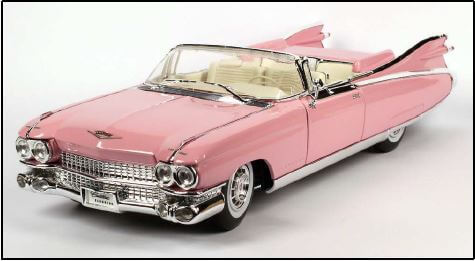
FIGURE I: Cadillac Eldorado, Pop Design (USA), 1959.
Write a comparative essay (at least ONE page) in which you discuss how FIGURE H and FIGURE I are characteristic of the design movements they represent.
Refer to the following to support your answer:
- Inspiration
- Aims
- Line
- Form
- Colour (5 x 2) (10) TOTAL SECTION B: 30
SECTION C: DESIGN IN A SOCIOCULTURAL/ENVIRONMENTAL AND SUSTAINABLE CONTEXT
QUESTION 5
Answer EITHER QUESTION 5.1 OR QUESTION 5.2.
5.1 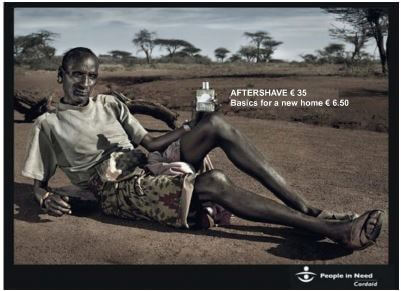
€35 = approximately R455,00; €6,50 = R84,50 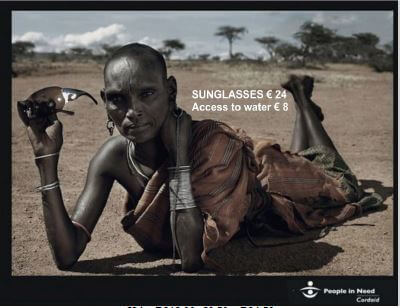
€24 = R312,00; €6,50 = R84,50
FIGURE J: Why You Can't Make It Rain Social Awareness Campaign by Saatchi & Saatchi (Netherlands), 2007.
5.1.1 Explain how the social message in the posters in FIGURE J is communicated. Refer to the following:
- Use of imagery
- Colour
- Use of juxtaposition (3 x 2) (6)
5.1.2 Write an essay (at least TWO pages) in which you discuss the work of ONE South African contemporary designer/design group
AND ONE international contemporary designer/design group who address sociocultural issues in their work.
Refer to the following in your discussion:
- Aims that relate to the concept of sociocultural design
- Name and discuss a designer/design group and ONE of his/her/their products that reflects social responsibility. (14) [20]
OR
5.2
5.2.1 Write an essay (at least ONE page) about an indigenous traditional craft that is practised in South Africa.
Refer to the following in your essay:
- The history and social functions of the traditional craft
- Materials, methods and processes
- A discussion of ONE example as well as the name(s) of the indigenous cultural community or indigenous craftsperson that produced it
- The value of practising this craft in contemporary South Africa. (10)
5.2.2 Write an essay (at least ONE page) on any ONE South African contemporary designer/design group who adapts traditional craft techniques/materials for modern usage.
Use the following structure when answering the question:
- Name the designer/group and his/her/their design product(s)
- Discuss how traditional techniques/methods and material have been applied to contemporary design and refer to specific examples to support your statements
- Discuss whether this/these product(s) make(s) a sociocultural contribution
You may NOT refer to any designer/design group that you discussed previously or design examples that appear in this question paper. (10) [20]
QUESTION 6
6.1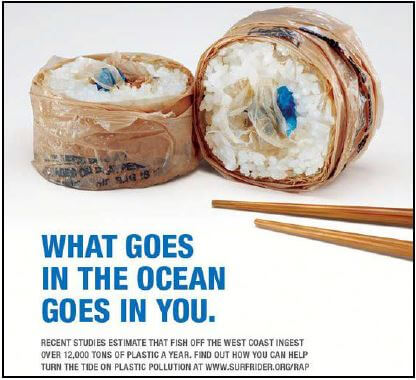
FIGURE K: Plastic Pollution Campaign by Surfrider (Europe), 2012. The 'food' above represents sushi rolls, Japanese seafood.
6.1.1 Discuss how the environmental warning is highlighted by the poster in FIGURE K above. (4)
6.1.2 Do you think that a poster campaign can be effective in bringing about behavioural change? Substantiate. (2)
6.2 Write an essay (at least ONE AND A HALF pages) in which you discuss the work of ONE South African contemporary designer/design group/studio and ONE international contemporary designer/design group/studio whose work addresses environmental/sustainable concerns.
Refer to the following in your discussion:
- General aims of the designer/design group/studio and his/her/their design product(s)
- Name ONE designer and his/her design and explain its impact on the environment
You may NOT refer to any designer/design group that you have discussed previously or design examples that appear in this question paper. (14) [20]
TOTAL SECTION C: 40
GRAND TOTAL: 100
DESIGN PAPER 1 GRADE 12 MEMORANDUM - AMENDED SENIOR CERTIFICATE EXAMS PAST PAPERS AND MEMOS MAY/JUNE 2018
DESIGN
PAPER 1
GRADE 12
AMENDED SCE PAST PAPERS AND MEMOS
MAY/JUNE 2018
MEMORANDUM
SECTION A: DESIGN LITERACY
QUESTION 1: 'UNSEEN' EXAMPLES [10 marks]
Answer EITHER QUESTION 1.1 OR QUESTION 1.2.
1.1 (Allocate a maximum of 2 marks for each bullet/aspect) 
The use of material in this pendant is an unusual combination of copper and brass materials that have been forged into contrasting forms. ? The material has been exposed to heat to make it malleable in order to stretch and shape the metal by beating it on a metal block or a mandrel. ? The copper has been treated to create a patina that makes it appear leather-like to suggest the idea of a corset. ? The turquoise stone adds variety and contrast in creating a striking design. ?
The bronze, copper and turquoise pendant is possibly inspired by the human form. ? The bronze wire lacing effect in the copper is reminiscent of a woman's corset and the blue, oval, turquoise stone implies a human head. ? The stone is attached to the pendant with a brass piece that looks like the neck and spine of a woman. The two curved brass pieces that attach to a chain that fastens around the neck could be inspired by clavicle bones. ?
The forging of the metal allows the designer/jeweller to create contrasting forms. The organic, copper form that resembles a corset contrasts with the mechanical simplified forms in brass resembling the body of a woman. ? The repetition of the oval form of the stone in the oval loops that attach to the chain creates a sense of rhythm. ? The form of the pendant as a whole is functional and will hang comfortably around the neck of the wearer.
The focal point is the turquoise stone. Its contrasting oval shape attracts the eye immediately. ? Additionally, it is the only cool colour in the warm yellow and red colour scheme created by the metals. ? The horizontally curved line leads the eye to the stone. The vertical line of brass that holds the turquoise stone leads the eye up to the stone. ?.
The cool blue colour of stone contrasts with the warm, yellow brass and red copper metals. ? The copper has been treated to produce a warm red patina. ? The warm, yellow brass and red copper metals create a sense of unity. ? [10]
Q.1.1 LEVEL | COGNITIVE SKILLS | WEIGHTING | QUESTIONS | MARKS (10) |
Lower Order | Remember, Recall, Recognise | 30% | 1.1 | 2 |
Understand, Explain, Describe | 1.1 | 1 | ||
Middle Order | Apply, Implement, Organise | 40% | 1.1 | 4 |
Higher Order | Analyse, Interpret | 30% | 1.1 | 1 |
Reflect, Judge | 1.1 | 1 | ||
Synthesis | 1.1 | 1 |
OR
1.2 [Allocate a maximum of 2 marks per design term for a total of 10 marks] 
The composition is made up of many organic lines that could be inspired by the Art Nouveau movement's whiplash line. ? The curvilinear lines that create frames around the mealies derived from the shape of the fibres at the top of each mealie and the shape of the mealie-meal bag. ? The diamond shape created by the lines produces a very dynamic half drop pattern. ?
Variation in tone is created in the design by the rendering technique used on the subject matter. A shading technique of fine lines is used to create 3-dimensionality and variation in tone as the highlighted motifs appear to be realistic on a flat dark background. ? The shading technique contrasts with the flat green background and simplified silhouettes of flying eagles and wings. ?
This contrast also creates a dynamic pattern surface. ?
? The subject matter of the wallpaper could possibly be inspired by the Arts and Crafts movement that used the everyday fauna and flora ? British designers found themselves surrounded by subject matter – like strawberries and small birds that lived in hedges. Similarly, the South African designer, Quagga, uses as subject matter the fauna and flora of South Africa, i.e. a mealie cob grown mostly in the Free State and acorns found in the Cape. ? The small brown birds of the Arts and Crafts movement that live in shrubs are substituted by the South African bird of prey, an eagle. ? Bags of mealie-meal, a staple diet for many South Africans, show the true South African influence. ?
The lines around the mirror image of the mealies and single large acorns create a symmetrical balance. ?The same balance occurs within the mirror image of the bags of mealie-meal that are framed with a curving whiplash line. ? The wallpaper has a drop repeat overall pattern made up of smaller symmetrically balanced units. ? This symmetrical balance stabilises the movement created by all the organic lines. ?
Rhythm is created by the repetition of the pattern units. ? The shape of the mealie kernels is repeated with the small dots that diminish in size, enclosed between the double outline at the top of the mealies, also creating a rhythm. ? The alternating direction and size of oak tree leaves that are arranged diagonally create a rhythmic vertically arranged pattern. ? [10]
Q.1.2 LEVEL | COGNITIVE SKILLS | WEIGHTING | QUESTIONS | MARKS (10) |
Lower Order | Remember, Recall, Recognise | 30% | 1.2 | 1 |
Understand, Explain, Describe, Classify | 1.2 | 2 | ||
Middle Order | Apply, Implement, Organise | 40% | 1.2 | 4 |
Higher Order | Analyse, Interpret | 30% | 1.2 | 1 |
Reflect, Judge | 1.2 | 1 | ||
Synthesis, Justify | 1.2 | 1 |
QUESTION 2: COMMUNICATION THROUGH DESIGN [10 marks] 
2.1 (Allocate 6 marks)
The fist ? placed above Mandela's head is a symbol of power and resistance. ? The white doves ? in the two top corners above the bullets are symbols of love and peace. ? The ballot box ? with paper with a cross on, in the rectangle in the middle of the top quarter of the poster, is a symbol of democracy. ? The horns ? jutting out on either side above the images of Mandela and Charlize could be symbols of Africa with the kudu being so abundant in Africa. ? The red hearts ? placed next to the bullets are symbols of love. ? The cranes ? in each
corner at the bottom of the poster could symbolise development and industry. ? Black and white hands ? holding each other symbolise unity and harmony between the two races. ?
Credit must be given to any other valid symbols and their meanings. (6)
2.2 (Allocate 4 marks)
The poster reflects 'cultural diversity' as it makes use of images and symbols that refer to various races, cultures and subcultures that form part of the broader community of South Africa. ? The round discs with triangular patterns refer to the earrings of the Zulu culture and the image of Charlize Theron could refer to the Western culture. ? Kwaito is a form of music that belongs to a specific subculture in South Africa. ? Various images refer to the different races that form part of our society, for example, the black and white hands holding each other and the white faces emerging from a sky with clouds above the head of Mandela. ? The poster puts all these images together to form a balanced and unified whole. The message communicated is that unity can be achieved even though South Africa is culturally so diverse. ? The fact that these images are placed to form a symmetrical whole conveys a sense of order and balance. ? The use of bright colours, like yellow, red, green and blue communicate happiness and vibrancy. ? Credit must be given to any other valid statements. (4) [10]
Q.2 LEVEL | COGNITIVE SKILLS | WEIGHTING | QUESTIONS | MARKS (10) |
Lower Order | Remember, Recall, Recognise, Name | 30% | 2.1 | 3 |
Understand, Explain, Describe, Classify | ||||
Middle Order | Apply, Implement, Organise | 40% | 2.1 2.2 | 3 1 |
Higher Order | Analyse, Compare, Interpret | 30% | 2.2 | 3 |
Evaluate, Reflect, Judge |
QUESTION 3 [10 marks]
Answer EITHER QUESTION 3.1 OR QUESTION 3.2.
3.1 [10 marks] (Allocate a maximum of 2 marks for each bullet/aspect) 

FIGURE D is possibly influenced by the geometric lines, forms and patterns of other traditional African wooden carved products and sculptures (credit can also be given if learners refer to the use of geometric lines by the Art Nouveau designer, Mackintosh), ? whereas FIGURE E's lines and shapes are reminiscent of the curvilinear lines used in Victorian and Art Nouveau combs.?
Both combs are used to decorate the hair. ? FIGURE D also functions as a ceremonial gift to acknowledge an imminent wedding ? whilst FIGURE E is worn as decoration during a wedding and other occasions, like a matric dance function. ? The shiny quality of FIGURE E signifies that it is probably used for smart evening functions. ?
The texture in FIGURE D is a combination of smooth and tactile surface detail. ? The horizontal bands show inscribed/engraved texture that contrasts with the smooth surface texture of the vertical 'bristles' of the comb that create a dramatic contrast. ? The variety of materials used in FIGURE E show tactile texture conveying lively movement and femininity. ? The smoothness of the pearls contrasts with the diamond encrusted, rough texture of the decorative curvilinear motifs. ?
FIGURE D combines rigid, horizontal, stylised, incised diamond decorative patterns with vertical, twirling, knotted strips, ? whereas FIGURE E uses of glittering, diamond-like stones and shiny pearls to form organic, leaf-like spiralling decorative patterns. ? FIGURE D is simplified and geometric in comparison to the complex, 'over the top' glitter appeal of FIGURE E. ?
FIGURE D is carved out of wood which gives it an organic, handcrafted character ? whereas FIGURE E consists of synthetic materials, like plastic, synthetic pearls and imitation diamonds typical of costume jewellery. ? FIGURE D has a durable quality whereas FIGURE E seems more fragile and breakable. ?
Credit must be given to any other valid statements.
NOTE: A maximum of ONLY 3 marks may be allocated for tabular comparison responses. Use the cognitive levels as guidelines. [10]
Q.3.1 LEVEL | COGNITIVE SKILLS | WEIGHTING | QUESTIONS | MARKS (10) |
Lower Order | Remember, Recall, Recognise | 30% | 3.1 | 1 |
Understand, Explain, Describe | 3.1 | 2 | ||
Middle Order | Apply, Implement, Organise | 40% | 3.1 | 4 |
Higher Order | Analyse, Compare, Interpret | 30% | 3.1 | 2 |
Evaluate, Reflect | ||||
Create, Synthesise | 3.1 | 1 |
OR
3.2 [10 marks] (Allocate a maximum of 2 marks for each bullet/aspect.) 



The function of the contemporary Synagogue in Mainz, seen in FIGURE G, is not at first evident as it is an unconventional, unique and modern structure which does not refer to traditional temple forms in any way. ? The temple of Bacchus in FIGURE F, on the other hand, is a familiar temple form and it is clearly a religious space in which to worship. ? FIGURE G combines public functions with religious functions. The orientation of the building in FIGURE G towards the East allows for two squares or open spaces to be created: an internal community garden functions as a place for recreation and celebration and a public square in front of the main entrance, facing towards the city centre, creates an open space for the neighbourhood within a densely built-up urban area. ? This synagogue complex in FIGURE G also functions as a place for adult education and a Hebrew school for children. The absence of any kind of gating or barriers means that it functions as a truly public space that is used for everyday activities, rare for a religious building, especially for a synagogue, in Germany. ?
The monumental, rectangular, simple structure of FIGURE F is situated on an immense raised plaza. ? The entablature rests on forty-two 19 m high, upright, unfluted Corinthian columns, banded together with iron, creating a typically classical structure dominated by horizontals and verticals. ? The structure of FIGURE G is, on the other hand, far more complex consisting of a very jagged and angular façade. ? The form is abstractly based on the Hebrew word for blessing and is curved around the public courtyard. ? The structure uses a perspectival play of three-dimensionality using multiple perspectives with the windows representing their vanishing points. ?
A variety of natural materials were used in the structure of FIGURE F. The columns, bases and capitals are made of limestone while the shafts are made of polished red Egyptian granite that supports the richly carved entablature. ? On the inside, the cella is decorated with Corinthian 'half-columns' flanking two levels of niches on each side, containing mosaic scenes of the birth and life of Bacchus. It is thought that the columns were erected in a rough state and only rounded off and polished once in place. ? The spatial quality of FIGURE G is enhanced by the use of repeated strips of transparent green ceramic tiles, which reflects the changing light conditions of its surroundings and creates a wide array of hues and shades. ?
The basilica style temple of Bacchus in FIGURE F, situated within the temple complex of Baalbek is one of the best preserved and grandest Roman temple ruins in the world. Influenced by the Ancient Greek and Mycenae architecture it is thought to have been constructed between 50 and 250 CE. ? The alternating high and low pointed shape of the Mainz Synagogue in FIGURE G is inspired by Hebrew writing and its relationship to space. ? In order to integrate this Jewish community centre (synagogue) into the residential neighbourhood of the Mainzer Neustadt that dates back to the late 19th century, the architect is also influenced by the use of a 'perimeter block pattern or enclosed courtyard' (Perimeter Building/Blockrandbebauung) which is a dominant architectural style in this urban area. ? Its jagged, fragmented structure also reflects the influence of the Deconstructivists' use of unstable, geometric fragmentation. ?
The temple of Bacchus is known for its impressive dimensions, richly decorated stone work and monumental gate with Bacchic styled figures. ? Enriched by some of the most refined reliefs and sculpture to survive from antiquity, the decorative stone carving on the architrave and frieze include rows of lions and bulls, which were motifs symbolically associated with the two deities. Its ornamentation served as an influential model for Neoclassical architecture in the 18th century. ? The technology needed to create the architrave structure is evidence of the Roman engineering capabilities. Blocks weighing from 66 tons to 100 tons were raised 19m above ground level using cranes and earthen banks to roll the blocks of limestone into position. ? The decoration of the synagogue in FIGURE G is far more uniform and simple than that of the temple in FIGURE F. ? The surface is covered completely in strips of glazed ceramic tiles. This surface as well as the various angles of the walls creates a visually exciting decorative, rippled and three-dimensional effect. ?
Credit must be given to any other valid statements or a comparison of a Classical and contemporary building that the candidate has studied.
NOTE: A maximum of ONLY 3 marks may be allocated to tabular comparison responses. Use the cognitive levels as guidelines.
Q.3.2 LEVEL | COGNITIVE SKILLS | WEIGHTING | QUESTIONS | MARKS (10) |
Lower Order | Remember, Recall, Recognise | 30% | 3.2 | 1 |
Understand, Explain, Describe, Classify | 3.2 | 2 | ||
Middle Order | Apply, Implement, Organise | 40% | 3.2 | 4 |
Higher Order | Analyse, Compare, Interpret | 30% | 3.2 | 1 |
Evaluate, Reflect | 3.2 | 1 | ||
Create, Synthesise, Justify | 3.2 | 1 |
TOTAL SECTION A: 30
SECTION B: DESIGN HISTORY
QUESTION 4 [30 marks]
4.1 Allocate 20 marks in total.
Allocate 10 marks for each movement. Note that ONLY ONE mark can be allocated for the name of a designer and product of each movement. Use the cognitive levels as guidelines.
This marking guideline supplies an answer for the following two possibilities:
- Neo-Classicism
- Deconstructivism
Neo-Classical designs aim to create simplified and ordered buildings or products that are balanced, calm and stable. ? They are influenced by the Classical ideals of the Greek and Roman eras. ? The designs reflect a revival of Classical building elements such as the column, colonnade, arch, pediment, entablature and portico. ? The aim is to use these elements to create harmonious, ordered structures that exude a sense of control, clarity and dignity. ? Neo-Classical design is a deliberate reaction to the excesses of Rococo design. The focus is now on ideals of virtue, honour, moral principles and responsibility. ?
Characteristic of this movement is the depiction of medallions, vine leaves, scrolls, Classic vases, natural elements and characters from ancient mythology, such as sphinxes and griffins. ? Typical of Neo-Classical buildings is the fact that they are mostly white which adds to the sense of purity and stillness. ? Columns are tall – almost to the full height of the building and repetition of these columns and colonnades is extreme, adding a sense of grandeur. ? Compositions are symmetrically balanced with an emphasis on proportion. ?
The USA Congress building by Thornton, Latrobe and Bulfinch, ? America, 1793–1830, expresses this simplicity and clarity very well. ? It has a completely white exterior, typical of Neo-Classicism, exuding calmness and purity. ? The design has an impressive dome and possesses an oculus similar to the Pantheon. Typical of Neo-Classicism is the repetition of tall columns and colonnades conveying order and stability. ?
Deconstructivist designs aim to subvert traditional ways of seeing and depicting. ? They aim to pull things apart and to investigate the relationships between the different components of a building or product. ? Their works are distorted, fragmented and re-assembled to illuminate new relationships which appear unstable and disrupted. ? The viewer is invited to find meaning in chaos, imbalance and disintegration. ? These designs exaggerate and dramatise. ?
Deconstructivism influence grew out of the writings of the French philosopher, Jacques Derrida, and his theory of deconstruction which states that deconstruction is evident at all levels of life and is the result of the interaction of opposites which exists in an unstable environment.? Other influences on Deconstructivist designs are the faceting of Cubism as well as the faceting, geometrising and emphasis on dynamism of Futurism.? The exploring of meaning to be found in non-aesthetic materials of Dada is another influence. ? Deconstructivism rejects the functionalism of Modernism as cold and impersonal.? Instead of an authoritarian design formula, creativity, variety and individuality are emphasised. ?
Characteristic of Deconstructivism is the use of displaced and distorted, angular, geometric forms creating a sense of dynamism and visual chaos. ? The overall form is fragmented, conveying uncertainty, unease or disruption. ? The structure rejects pure function and traditional ideas of harmony, unity and stability. ?
An example of Deconstructivism is Frank Gehry's 'Foundation Louis Vuitton Contemporary Art and Performance Space'. ? The building appears as a series of planes of steel and glass that have been pulled apart to reveal what lies beneath the surface. ? The planes lie in different directions, in line with the Deconstructivist theory of interaction of opposites, to reflect a naturally unstable environment. ? This adds to the feeling of movement and space within the design. ? Twelve separate 'sails' encase the building, obscuring its function. ?
In this way the design rejects pure function and the traditional ideas of harmony, unity and stability. ? The building has been described as a 'cathedral of light' and a 'glass cloud'. ? (20)
Q.4.1 LEVEL | COGNITIVE SKILLS | WEIGHTING | QUESTIONS | MARKS (20) |
Lower Order | Remember, Recall, Recognise, Name | 30% | 4.1 | 2 |
Understand, Explain, Describe, Classify | 4.1 | 4 | ||
Middle Order | Apply, Implement, Organise | 40% | 4.1 | 8 |
Higher Order | Analyse, Compare, Interpret | 30% | 4.1 | 2 |
Evaluate, Reflect | 4.1 | 1 | ||
Create, Synthesise, Justify | 4.1 | 3 |
4.2 [10 marks] (Allocate a maximum of 2 marks for each bullet/aspect.) 

Both cars are inspired by the machine-age. ? The sleek, elongated form of the Bugatti type 57 shows Art Deco's interest in Machine Age, streamlined forms ? and the Cadillac Eldorado's use of fins seems to be inspired by the Modernist's interest in the use of fish forms to depict speed. ?
Art Deco designers aim to create escapist, glamorous, luxury items. ? The Bugatti Type 57 clearly reflects this aim as it is a large, luxury car designed for comfortable travel. ? The Cadillac Eldorado is also a luxury car but the Pop Era's aim to reflect the popular, everyday culture of the time can be seen in the fact that it is exudes a less serious, more fun mood than the Bugatti. ?
The Bugatti is made up of long, sleek curvilinear lines that help to depict both speed and elegance. ? The Cadillac Eldorado's lines are also long and streamlined but they do not end in bulbous curves – instead, they are more angular and sharp exuding energy and fun. ?
The forms of the Bugatti Type 57 car are solid and heavy contributing to its grand and powerful appearance ? whereas the forms of the Eldorado Cadillac are more linear, rectangular and light. ? The bulbous, curving bonnet of the Bugatti could be inspired by the organic forms of Art Nouveau as well as by the teardrop forms resulting from the study of aero-dynamics. ? The Cadillac, on the other hand, consists of flatter, rectangular forms possibly inspired by the Machine Age. ?
The Bugatti's deep red and cream colour-scheme is typical of Art Deco's use of dramatic, theatrical colour and exudes pomp and splendour. ? The pale pink of the Cadillac, on the other hand, is light-hearted. ? It is reminiscent of ice-cream and popular plastic products and reflects the Pop Era's love for the new, artificial range of colours that became possible in paint production. ?
Credit must be given to any other valid statements.
NOTE: A maximum of ONLY 3 marks may be allocated for tabular comparison responses. Use the cognitive levels as guidelines. (10)
Q.4.2 LEVEL | COGNITIVE SKILLS | WEIGHTING | QUESTIONS | MARKS (10) |
Lower Order | Remember, Recall, Recognise, Name | 30% | 4.2 | 1 |
Understand, Explain, Describe, Classify | 4.2 | 2 | ||
Middle Order | Apply, Implement, Organise | 40% | 4.2 | 4 |
Higher Order | Analyse, Compare, Interpret | 30% | 4.2 | 1 |
Evaluate, Reflect, Judge | 4.2 | 1 | ||
Create, Synthesise, Justify | 4.2 | 1 |
TOTAL SECTION B: 30
SECTION C: DESIGN IN A SOCIOCULTURAL/ENVIRONMENTAL AND SUSTAINABLE CONTEXT
QUESTION 5 [20 marks]
Answer EITHER QUESTION 5.1 OR QUESTION 5.2.
5.1 5.1.1 (Allocate 6 marks) 

- Use of imagery (Allocate 2 marks)
The social message in the posters above is communicated effectively by the images of emaciated models, portrayed in poses similar to those used by models in high end fashion magazines. ? The Masai models pose with expensive superficial products associated with Western daily life that are not a necessity in their day to day living. ?
The use of font (words written) allows easy understanding of the message. ?
- Colour (Allocate 2 marks)
The Masai models are set against a brown, dreary, barren landscape that depicts drought and may also suggest famine. ? The products that the Masai models are holding on display are catching the eye because of the shiny and sparkling yellow light reflected by the sun on the plastic material of the sunglasses ? and the plastic lid of the aftershave. ? The use of colour in the message (the words) stands out. ?
- Use of juxtaposition (Allocate 2 marks)
The models pose with expensive bling products associated with a fashionable glamorous Westernised existence. However, the Masai models show physical signs of poverty and malnourishment. ? The contrast between the monetary value of the fashion items that the models pose with and that of common basic necessities (clean water, shelter and food) is further emphasised by the written caption. ? This highlights the difference in terms of what money is spent on in first world countries and what that kind of financial facility might mean in third world countries. ?
Credit any other valid statements. (6)
5.1.2 Allocate 14 marks in total, 7 marks per case study. Allocate 1 mark for the name of the designer and the name of the product.
ONE CONTEMPORARY SOUTH AFRICAN DESIGNER/DESIGN GROUP
- Aims that relate to the concept of sociocultural design
Aims of the Lumkani fire alarm is to address/alleviate/improve issues in society that affect the quality of peoples' lives. ? The Lumkani fire alarm is designed for the informal settlements of South Africa, where crowded conditions and open fires used for cooking can result in house fires. ? Fires can easily spread from house to house, devastating and displacing entire communities. ?
- Name and discuss a designer/design group and ONE of his/her/their products that reflects social responsibility
Lumkani Fire Alarm by Socio Tech Institute ?
The Lumkani fire alarm was designed in 2015 by SocioTech Institute. It has a cellular and radio network built in, which alerts neighbours within a 60-metre radius of the location of the fire, through an audio alarm and SMS messages, so the community can respond quickly to extinguish a fire. ? Shelters and shacks in informal settlements are built by hand out of readily available materials that are often highly flammable. ? In addition, these shacks are also often built very close together, hence creating optimal conditions for the rapid spreading of a fire. ? Because of the unplanned nature of informal settlements, these communities are also rarely mapped out making it exceptionally difficult for rescue services to identify the affected places and respond promptly to a fire. ?
ONE INTERNATIONAL DESIGNER/DESIGN GROUP
- Aims that relate to the concept of sociocultural design
Vestergaard LifeStraw is developed to filter out virtually all of the microbiological contaminants that make water unsafe to drink. ? The technology is a personal 'straw-like' filter. It helps people in developing countries who do not have running water piped in from municipal sources and also gives access to safe water in emergency settings following natural disasters when water is contaminated. ?
- Name and discuss a designer/design group and ONE of his/her/their products that reflects social responsibility
Lifestraw by Vestergaard ? The LifeStraw was developed by Vestergaard in 1994. It is a filter that can remove Guinea worm larvae from water it is contaminating. This cloth filter later evolved into a more effective pipe form in 1999. ? Today more than 37 million LifeStraw Guinea Worm filters have contributed to the near-eradication of the disease. ? The LifeStraw team is committed to redefining the safe drinking water space through technology innovation and product quality and design. ? In doing so, our work is driving sustainable access to safe drinking water by engaging governments, donors, and individual consumers to understand the problem and become an active part of the solution. ? Vestergaard recognised that, while the LifeStraw technology was effective for many uses, innovation around product design was important to meet the needs of different groups of people. ? In 2008, LifeStraw technology was adapted for in-home use and the LifeStraw Family water purifier was developed to purify larger volumes of water. ?
The LifeStraw portfolio has continued to evolve to include the high volume LifeStraw Community purifier for institutional settings like schools and clinics (introduced in 2013), ? the LifeStraw Go refillable water bottle (2014) and LifeStraw Mission, a high-volume, collapsible bag ideal for campsites, group hikes and expeditions launched in 2015. ? A portion of the proceeds of consumer sales for any LifeStraw product anywhere in the world goes toward the purchase of LifeStraw Community purifiers which are distributed to schools in developing communities. ? As a result, each consumer purchase provides one school child in a developing community with safe water for an entire school year. ? LifeStraw is ideal for hiking, backpacking, camping, travel and emergency preparedness. ? The straw-style filter design lets you turn up to 1 000 litres of contaminated water into safe drinking water. ? It lets you drink directly from streams and lakes or from any container. ? Uses advanced hollow fibre membrane technology to filter up to 264 gallons or 1 000 litres of water to 0,2 microns. It removes 99,9999% of waterborne bacteria, including E. coli and salmonella and 99,9% waterborne protozoa, including Giardia and Cryptosporidium. ?
Credit any other valid statements. (14) [20]
Q.5.1 LEVEL | COGNITIVE SKILLS | WEIGHTING | QUESTIONS | MARKS (20) |
Lower Order | Remember, Recall, Recognise, Name | 30% | 5.1.1 | 2 |
Understand, Explain, Describe, Classify | 5.1.2 | 4 | ||
Middle Order | Apply, Implement, Organise | 40% | 5.1.1 5.1.2 | 4 4 |
Higher Order | Analyse, Compare, Interpret | 30% | 5.1.2 | 3 |
Evaluate, Reflect, Judge | 5.1.2 | 2 | ||
Create, Synthesise, Justify | 5.1.2 | 1 |
OR
5.2
5.2.1 (Allocate 10 marks, 2 marks per requirement)
XHOSA BEADWORK
- History and social functions Beadwork is used in African society as a means of social differentiation; used to portray the social role, life stage, spiritual state or marital status of the wearer within his/her community. ? Beaded objects also form an important part of traditional African dress and for special occasions such as weddings and festivals. ?
- Materials, methods and processes The materials utilised in traditional Xhosa beadwork are animal sinew and glass beads of which the white beads were favoured. ? Pins used to attach the finished product to the garment are also used. ? Generally the brick or diamond stitching method is used to create precise, geometric patterns and shapes. ?
- A discussion of ONE example and the name(s) of the indigenous cultural community or craftsperson that produced it. The keeper-of-the-heart necklace by the Xhosa cultural community. ? The keeper-of-the-heart necklace is a small beaded panel necklace commonly worn by Xhosa women around their necks communicating how they feel about themselves. ? The necklace has a front square or rectangular panel on which there appears a stylised human figure in coded form. ? The pose of the stylised figure tells us that the wearer considers themselves to be either hardworking, a good dancer and in some instances too old to dance. ? The keeper-of-the-heart necklace is sometimes also worn by men, indicating that the wife is either a good dancer, hard worker or a good housekeeper. ?
- The value of practising this craft in contemporary South Africa Practising traditional craft in contemporary South Africa helps to keep the craft alive and in this way preserves African traditional practices and culture. ? The practice also creates economic prospects for the designer and also gives the designer an opportunity to empower his/her community. ? This is achieved by imparting skills to the community that can potentially improve the economic situation of the community. ?
Credit any other valid statements. (10)
5.2.2 (Allocate 10 marks)
- Name of designer/group and his/her/their design product(s) Xhosa-inspired beadwork iPhone case, Vukile Batyi and Laduma Ngxokolo ?
- A discussion of how traditional techniques/methods and material have been applied to contemporary design. Refer to specific examples to support your statements. The Xhosa beadwork-inspired iPhone case cover is designed using glass beads, drawing on traditional beading techniques to create a 21st century ubiquitous accessory. ? iPhone cases are as popular as the iPhone itself. ? iPhone cases are a fashionable add-on that shields iPhones from screen and moisture damage. ? Inspired by his late aunt, Batyi draws on traditional beading skills to create one-of-a kind, bright and bold designs for the South African and international market. ?
- Discuss whether this/these product(s) make(s) a sociocultural contribution The patterns in which the beads have been laid out are predominantly used in and found in Xhosa culture. ? The use of a traditional technique to adorn and protect a technological gadget creates a contrast of opposites, a new age digital accessory decorated and protected by an old fashioned handmade element. ? The use of Xhosa-inspired patterns for a contemporary design is a way of celebrating previously marginalised societies by acknowledging the contribution to the design world. ? Traditional designers whose work influenced these covers can be paid royalties for the designs thus creating jobs for people from a traditional background. ? Durable traditional Xhosa beadwork technique is used by local skilled South African artisans, thus providing a platform for them to sell their quality items to local and international buyers. ? (10) [20]
Q.5.2 LEVEL | COGNITIVE SKILLS | WEIGHTING | QUESTIONS | MARKS (20) |
Lower Order | Remember, Recall, Recognise, Name | 30% | 5.2.1 5.2.2 | 2 1 |
Understand, Explain, Describe, Classify | 5.2.1 5.2.2 | 2 1 | ||
Middle Order | Apply, Implement, Organise | 40% | 5.2.1 5.2.2 | 4 4 |
Higher Order | Analyse, Compare, Interpret | 30% | 5.2.2 | 2 |
Evaluate, Reflect | 5.2.1 | 2 | ||
Create, Synthesise, Justify | 5.2.2 | 2 |
QUESTION 6 [20 marks]
6.1
6.1.1 (Allocate 4 marks)
The environmental warning in FIGURE K warns people of the dangers caused by plastic pollution of the ocean. ? The poster creates awareness of the impact of plastic pollution on the environment of the sea. This affects the quality of the water supply contained in the ocean, as well as the lifespan of ocean animals and marine plants. ? In humans, plastic pollution can result in severe reactions and illness through physical contact or ingestion of water or food from the ocean. ? The strength of the message is enhanced with the use of a font which is bold, sans serif and uppercase. ? The image of delicious sushi rolls where plastic replaces the seaweed strongly highlights the message of environmental pollution getting out of hand. ?
Credit any other valid statements. (4)
6.1.2 (Allocate 2 marks)
Yes, visually shocking images in a poster campaign can impact on and change people's perceptions of, ? for example the impact of pollution could encourage them to change their habits after seeing shocking images. ?
OR
No, poster campaigns are sometimes not effective in bringing about a change in people's behaviour, because people forget the message of the poster as soon as they walk away from it. ? Out of sight, out of mind is often the people's reaction. ? Legislation should be tightened in various countries to enforce stricter laws regarding issues that impact the environment. ?
Credit any other valid statements. (2)
6.2 (Allocate 14 marks in total, 7 marks per case study)
EXAMPLE OF A SOUTH AFRICAN ENVIRONMENTAL DESIGNER/DESIGN GROUP
Name of the design company: ZETU, name of the shoe: Izimbadada ? The owner of ZETU, a company that manufacturers shoes in rural KwaZulu Natal, and a shoe designer, Reggie Xaba, aims to be fashionable, stylish and edgy whilst embracing their Africaness. ? Izimbadada shoes were made popular by Mbaqanga and Maskandi (South African music genres with rural Zulu roots) musicians who prefer them for their durability when performing Zulu dancing. ? The design of the shoe is inspired by the familiar African surroundings, like the dusty terrains of KwaZulu-Natal, the bustling streets of Johannesburg, Lagos, and Nairobi or of any other African city. ?
These rubber sandals, made entirely from the tread of old tyres were originally worn by people from rural areas who moved to cities to settle in hostels, but has since penetrated the broader spectrum of society as a fashion item. ? The shoes are made heavy and sturdy because Zulu dancing involves a lot of hard stomping that is quite hard on the feet. ? The lighter versions of the traditional handcrafted sandal use modern materials and cutting methods and are decorated with trendy and original patterns. ? While the sandals have a distinguishable sole made from car tyres, designs differ and are often custom-made according to the buyer's request. ? The sandals are comfortable and trendy, with a re-imagined aesthetic of traditional wear. ? This can include cow hide embellished straps to straps that are beaded or embroidered. ?
The creation of these products helps the environment to be cleaner as they are manufactured from waste material. ? These tyres were supposed to be disposed on the landfills but instead they have received a new life as shoes. ? The rubber salvaged from the tyres also reduces the carbon footprint on the environment. ?
Tyres are non-renewable resources ? with the majority of people and the commercial transportation industries discarding their old tyres in landfills. The use of these tyres as materials in the design of products helps minimise waste and the negative impact on the environment. ?
EXAMPLE OF AN INTERNATIONAL DESIGNER
(Allocate 7 marks per case study)
Name of the designer: Laurence Brabant, name of the product: Cold Cuts ? The Cold Cuts collection by Laurence Brabant takes recycled wine bottles and turns them into serving ware and glasses. ? Their aim is to produce unpretentious discreet designs through sophisticated, functional, simple objects. ? The wine bottles are cut and chamfered. Laurence Brabant, uses renewable woods like beech and cork to craft the handles. ?
All Laurence Brabant Editions are handmade in their studio. ? No moulds or modifications are used. Each piece is unique being made in one go that requires seasoned skill and concentration. ? A recycled wine bottle is chosen as a material, for it enables Laurence to produce designs that were otherwise limited by pipe blowing. ? These pieces are heat-resistant and deceivingly durable. Laurence Brabant has managed to create some unique designs that stand out from ordinary recycled bottles. Brabant created unique kitchen utensils like some classy wine glasses and some cute and attractive glasses and more. ?
With Cold Cuts the designer is playing with some standards: these wine bottles which are cut and chamfered have always the same inner diameter as they are turned into vases, candle holders and spoons. ?
The bottle is not bio-degradable, recyclable, up-cyclable or even re-usable bottles that helps to reduce pollution of the environment. ? Recycling reduces manufacturing costs and processes which in return yield bi-products (chemicals) that are imposing danger to the environment. ? With Cold Cuts, Laurence Brabant assists towards cleaning and saving planet earth from hazardous material that damage the environment. ? Glass is a renewable material that can be melted to create new design products. ? The abundant wasted glass means that glass is readily available with our ever growing world population needs. ? (14) [20]
Q.6 LEVEL | COGNITIVE SKILLS | WEIGHTING | QUESTIONS | MARKS (20) |
Lower Order | Remember, Recall, Recognise, Name | 30% | 6.1.1 6.1.2 | 1 1 |
Understand, Explain, Describe, Classify | 6.2 | 4 | ||
Middle Order | Apply, Implement, Organise | 40% | 6.1.2 6.2 | 2 6 |
Higher Order | Analyse, Compare, Interpret | 30% | 6.1.1 | 1 |
Evaluate, Reflect, Judge | 6.1.2 | 1 | ||
Create, Synthesise, Justify | 6.2 | 4 |
TOTAL SECTION C: 40
GRAND TOTAL: 100
COMPUTER APPLICATION TECHNOLOGY PAPER 1 GRADE 12 QUESTIONS - AMENDED SENIOR CERTIFICATE EXAMS PAST PAPERS AND MEMOS MAY/JUNE 2018
COMPUTER APPLICATION TECHNOLOGY
PAPER 1
GRADE 12
AMENDED SCE PAST PAPERS AND MEMOS
MAY/JUNE 2018
INSTRUCTIONS AND INFORMATION
- Owing to the nature of this practical examination, it is important to note that, even if you complete the examination early, you will NOT be permitted to leave the examination room until all the administrative functions associated with the examination have been finalised. During the examination, normal rules regarding leaving the examination room apply.
- Enter your examination number in the header or footer of EVERY document that you create or save, where applicable.
- The invigilator will give you a CD/DVD/flash drive containing all the files needed for the examination OR you will be told where the files can be found on the network or computer. If a CD/DVD/flash drive has been issued to you, you must write your examination number and centre number on the CD/DVD/flash drive. If you are working on the network, you must follow the instructions provided by the invigilator/educator.
- A copy of the master files will be available from the invigilator. Should there be any problems with a file, you may request another copy from the invigilator.
- This question paper consists of SEVEN questions.
- Answer ALL the questions.
- Ensure that you save each document using the file name given in the question paper. Save your work at regular intervals as a precaution against possible power failures.
- Read through each question before answering or solving the problem. Do NOT do more than is required by the question.
- At the end of the examination, you must hand in the CD/DVD/flash drive given to you by the invigilator with ALL your answer files saved onto it, OR you should make sure that ALL your answer files are saved on the network/computer as explained to you by the invigilator/educator. Make absolutely sure that all files can be read. Do NOT save unnecessary files/folders and do NOT hand in duplicate answer files/folders.
- The information sheet that has been provided with the question paper MUST BE COMPLETED AFTER THE THREE-HOUR EXAMINATION SESSION. Hand it to the invigilator at the end of the examination.
- During the examination you may consult the offline help functions of the programs that you are using. You may NOT use any other resource material.
- Unless instructed otherwise, use formulae and/or functions for ALL calculations in spreadsheet questions. Use absolute cell references only where necessary to ensure that formulae are correct when you copy them to other cells in a spreadsheet.
- NOTE: All formulae and/or functions should be inserted in such a manner that the correct results will still be obtained even if the data changes.
- If data is derived from a previous question that you could not answer, you should still proceed with the questions that follow.
- In all questions involving word processing, you should set the language to English (South Africa). The paper size is assumed to be A4 Portrait, unless instructed otherwise.
- Ensure that the regional settings are set to South Africa and date and time settings, number settings and currency settings are set correctly.
- The examination folder/CD/DVD/flash drive that you receive with this question paper contains the files listed below. Ensure that you have ALL the files before you begin with this examination.
- 1Artists Word processing file
- 1Daniella Image file
- 2Art Image file
- 2Top15SA Word processing file
- 3Sales Spreadsheet file
- 4Novice Spreadsheet file
- 5ArtData Database
- 6Expensive HTML file
- 6No1 Image file
- 6No3 Image file
- 7ForSale Spreadsheet file
- 7Global Word processing file
- 7Ruga Word processing file
- 7Watercolour Database
QUESTIONS
SCENARIO South Africa has a wealth of artistic talent. You were asked to research some of the artists and their work. |
QUESTION 1: WORD PROCESSING
Open the 1Artists word processing document, which contains background information on the ten top young South African artists. Insert your examination number in the header or the footer.
1.1 Change the top margin of the document to 2.5 cm. (1)
1.2 Format the heading 'Ten young artists of South Africa' as follows:
- Centre the heading.
- Expand the character spacing by 2 pt. (3)
1.3 Add the following to the source 'Culture Trip (2017)':
- 'S Keam' as the author
- 'South Africa's 10 Young Artists' as the name of the web page
NOTE: If a warning appears, select 'Yes'. (3)
1.4 Format the paragraph that starts with 'South Africa boasts …' and ends with '… in South Africa' with the same paragraph spacing as the rest of the paragraphs in the document. (1)
1.5 Find the last sentence in the first paragraph that starts with 'We discover …' and ends with '… citation here)'. Make the following changes:
1.5.1 Display only the year in the citation 'Webb, 2017'. Do NOT change the source. (1)
1.5.2 Replace the text 'insert citation here' with a citation to the source 'Young Talent (2017)'. (1)
1.6 Insert a text box above the text 'Athi Patra-Ruga' and add the text 'DID YOU KNOW?' (2)
1.7 Find the numbered text below the heading 'Athi Patra-Ruga'.
Replace the automatic numbers with bullets using the '' symbol (Webdings character code 162). (2)
1.8 Use a word processing feature to display ALL occurrences of the word 'culture' in small caps. (2)
1.9 Insert the image 1Daniella found in the examination folder as follows:
- The image should appear to the right of the paragraph with the heading 'Daniella Mooney'.
- The size of the image should be exactly the same as the image of 'Athi Patra-Ruga' in the previous paragraph. (5)
1.10 Add the caption above the last image in the document to appear as 'Figure 5: Destinies'. (2)
1.11 Insert a table of figures below the text 'Table of Figures' at the end of the document. Display the table of figures in the 'Simple' format. (2)
1.12 Insert a text watermark as follows:
- Insert the text 'Top Ten' as the watermark text.
- Do NOT display the watermark on the first page. (4) Save and close the 1Artists document. [29]
QUESTION 2: WORD PROCESSING
Open the 2Top15SA word processing document, which contains a list of 15 of the most famous South African artists.
2.1 Edit the cover page as follows:
- Insert your examination number as the author.
- Change the image on the first page to the 2Art image found in the examination folder.
- Find the text that starts with 'Although it is impossible ...' and ends with '… no particular order).' on the third page. Move this text to the abstract on the cover page. (5)
2.2 Change the page numbers of the document as follows:
- Start the numbering on the page after the table of contents with 1.
- Change the page numbering format to 'Page X of Y'.
- The cover page and the table of contents page should NOT be numbered. (3)
2.3 Find the heading 'Marlene Dumas', the paragraph about Marlene Dumas and the image of Marlene Dumas. Change the paragraph setting to display the heading, paragraph and image together and not split over two pages. (2)
2.4 Find the table under the heading 'Explore our Art Galleries' and change the whole table as follows:
- Apply shading to the row containing headings in any colour of your choice.
- Sort the table alphabetically, first by location and then by gallery name.
The first four rows of the table should appear as below: (4)
Province | Gallery Name | Location |
KwaZulu-Natal Art Galleries | Imbizo Gallery | Ballito |
Western Cape Art Galleries | Magpie Art Collective Gallery | Barrydale |
Gauteng Art Galleries | Afrinova | Braamfontein |
Gauteng Art Galleries | Wits Art Museum | Braamfontein |
2.5 Find the table under the heading 'Most famous works'. Insert a formula in the first cell in the last row to display the total number of artists listed in the table. (2)
2.6 Display only the text that starts with the heading 'Photo credits …' and ends with '… cross reference here)' on a landscape page. (2)
2.7 Insert a cross reference to the caption 'Figure 3: Irma Stern' to replace the text '(Insert cross reference here)' at the end of the document. (2)
Save and close the 2Top15SA document. [20]
QUESTION 3: SPREADSHEET
NOTE:
- Use formulae and/or functions for ALL calculations in the spreadsheet.
- Use absolute cell references ONLY where necessary to ensure that formulae are correct when you copy them to other cells in the same column (copy down).
- All formulae and/or functions should be inserted in such a manner that the correct results will still be obtained even if the existing data changes.
Open the 3Sales spreadsheet, which includes a summary of the gallery's sales. Work in the Summary_Opsomming worksheet.
3.1 Change the vertical alignment of row 1 to centre. (1)
3.2 Insert a function in cell K3 to determine the average selling price of all the art pieces sold (column G). (2)
3.3 Insert a COUNTIFS function in cell K4 to determine the number of art pieces sold in 30 days or less (column F) AND sold for an amount of more than R2 000 (column G). (5)
3.4 Insert a function in cell K5 to determine the total value of all the art pieces sold (column G), for experience code 1 (column D). (4)
3.5 Each art piece must have a selling code.
Insert a combination of functions in cell H3 to create the code as follows:
- The artist's surname (column B)
- Followed by the first two letters of the artist's name (column A)
- Followed by a random three-digit number (7)
Work in the Chart_Grafiek worksheet.
3.6 Change the chart in the worksheet to appear as shown below:
- Insert data labels for the amounts of each code. Ignore the position of the data labels.
- Remove the legend.
- Set the major axis units to 10 000.
- Fill only the back wall of the chart with any colour of your choice.
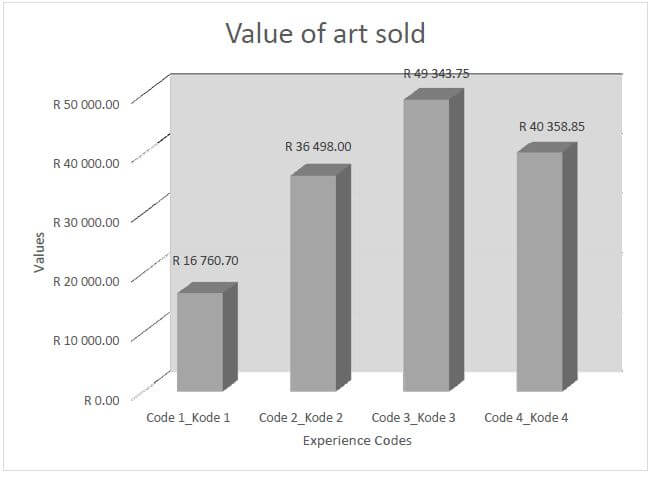 (4)
(4)
Save and close the 3Sales spreadsheet. [23]
QUESTION 4: SPREADSHEET
NOTE:
- Use formulae and/or functions for ALL calculations in the spreadsheet.
- Use absolute cell references ONLY where necessary to ensure that formulae are correct when you copy them to other cells in the same column (copy down).
- All formulae and/or functions should be inserted in such a manner that the correct results will still be obtained even if the existing data changes.
Open the 4Novice spreadsheet, which contains information about new artists' work displayed in a gallery. Work in the Artist_Kunstenaar worksheet.
4.1 Format row 1 as follows:
- Merge cells A1:M1, but DO NOT centre the text.
- Increase the font size to 32.
- Apply any gradient fill to cells A1:M1. (3)
4.2 The e-mail addresses in column C should NOT include upper case letters.
Use an appropriate function in column D to display the data only in lower case.
Copy the function to the rest of the cells in the column. (2)
4.3 Use an appropriate LOOKUP function in cell F3 to determine the description in the Code_Kode worksheet by using the 'Type code' in column E. (4)
4.4 The percentage of the commission depends on the artist's experience code in column G.
Use a function in cell H4 to determine the commission percentage as follows: (6)
CODE | PERCENTAGE |
3 | 20% |
2 | 25% |
1 | 33% |
4.5 The art gallery will display the art pieces for a certain number of months, as given in column I.
The date on which the display of the art piece starts appears in column J. Use a function in cell K5 to determine the date at which the artist's art pieces will be removed. (5)
4.6 Change the format of the values in column L to currency. (1)
4.7 Each artist sets a price (column L) for his/her art piece. The gallery's commission is calculated by using the artist's price and adding the commission percentage (column H). Insert a formula in cell M6 to calculate the selling price of an art piece by adding the percentage of the gallery's commission to the artist's price. (3)
4.8 All art pieces in the spreadsheet are exhibited in the art gallery currently.
If the date in column K is BEFORE the current date, the art piece should have been removed.
Use conditional formatting to shade the cells in column K with any colour of your choice to show which art pieces should be removed.
NOTE: This feature must work on any day. (3) Save and close the 4Novice spreadsheet. [27]
QUESTION 5: DATABASE
Open the 5ArtData database, which stores data of new artists at the gallery.
5.1 Edit the tblArtists table as follows:
5.1.1 Remove the ID field. (1)
5.1.2 Change the data type of the Name field to a more suitable data type. (1)
5.1.3 Set the field properties of the Cellnumber field so that the user is forced to enter data in this field. (1)
5.1.4 Set the field properties of the StreetName field so that it will not accept more than 25 characters. (1)
5.1.5 Insert a field named PostalCode between the City field and the E-mail field. (2)
5.1.6 Change the format of the E-mail field to display the address in lower case. (1)
5.1.7 The Genre field allows the user to choose only one option from a list of options. Change a property of the Genre field to allow the user to choose more than one genre.
NOTE: If a warning appears, select 'Yes'. (1)
5.1.8 Create an input mask on the ArtistCode field to ensure that the user inserts a code for the artist in the following format:
- ONE compulsory letter
- Followed by ONE compulsory letter or digit
- Followed by at least ONE digit, but possibly TWO digits Example of a valid ArtistCode include: x35, Aa3, gg52 (4)
Save and close the tblArtists table.
5.2 Create a new form called frm5_2 based on the tblArtists table.
- Include ALL the fields.
- Add your examination number in the form header.
- Change the font colour of the Name field so that ALL names display in red.
Save and close the frm5_2 form. (5) 5.3 Open the qry5_3 query based on the tblData table.
- Modify the query so that it displays the total amount of each TypeDescription, as shown below.
- Sort the values from the highest to the lowest on the ArtistPrice field to display as follows:
TypeDescription | SumOfArtistPrice |
Drawing | R 73 441.00 |
Watercolour | R 70 690.00 |
Architecture | R 67 903.00 |
Sculpture | R 57 224.00 |
Crafts | R 56 767.00 |
Painting | R 54 935.00 |
Ceramics | R 45 480.00 |
Design | R 45 061.00 |
Printmaking | R 43 103.00 |
Filmmaking | R 37 141.00 |
Save and close the qry5_3 query. (5)
5.4 An error was made in the database when dates were captured incorrectly. Open the qry5_4 query and do the following:
- Add a calculated field called NoDays, which will determine for how many days the work of art has been exhibited, using the DateIn field and the DateOut field. Errors will show as a negative value.
- Display only the error records where the DateIn value is after the DateOut value.
- Display only the DateIn field, the DateOut field and the new calculated field, NoDays.
Save and close the qry5_4 query. (7)
5.5 Open the qry5_5 query and do the following:
Display only the records of those artists whose price (ArtistPrice) was more than R2 500 AND whose art pieces were sold (Sold).
Save and close the qry5_5 query. (4)
5.6 Open the rpt5_6 report and turn on 'Group & Sort', if it is not already displayed.
- Add the current date and time in the report footer.
- Insert a function to determine the total ArtistPrice for art pieces per TypeDescription.
- Change the grouping of the DateOut field to display per month instead of per year.
- Ensure that the text box in the DateOut header displays the month.
Save and close the rpt5_6 report. (7)
Save and close the 5ArtData database. [40]
QUESTION 6: WEB DESIGN (HTML)
Open the incomplete 6Expensive web page in a web browser and also in a text/ HTML editor (NOT a word processing program such as Word).
NOTE:
- Question numbers are inserted as comments in the coding as guidelines to show approximately where the answer(s) should be inserted.
- Your web page may display differently depending on the web browser used.
- An HTML tag sheet has been attached for reference.
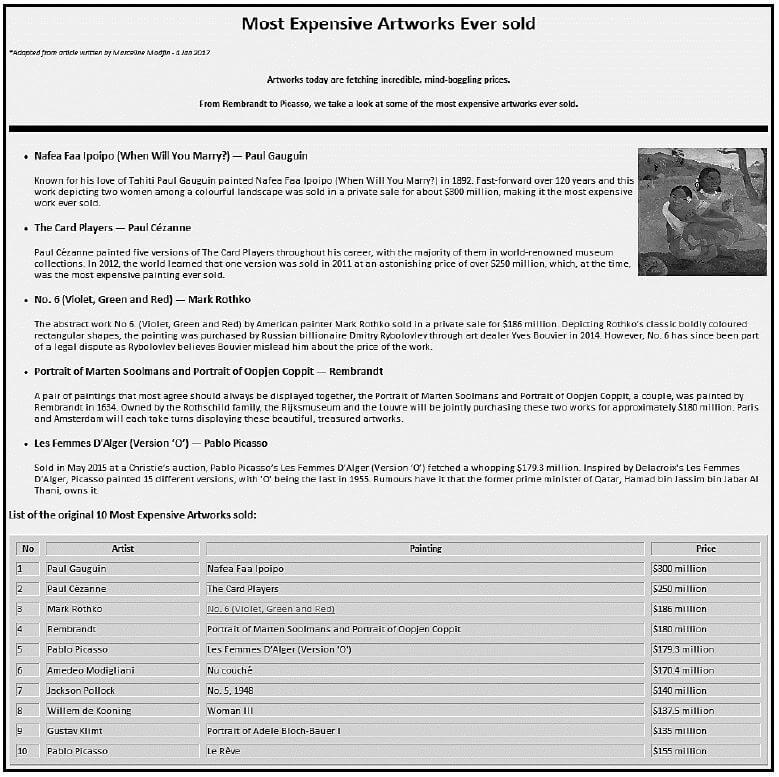
Your final web page should look like the example below.
NOTE: Use the example on the previous page to help you with this question.
6.1 Insert tags to ensure that the text 'Most Expensive Artworks!' displays in the browser tab. (1)
6.2 Change the font of the entire web page to 'Calibri'. (2)
6.3 Change the text 'Most Expensive Artworks Ever sold' as follows:
- Display the text as a 'Heading 1' style heading.
- Centre the heading. (2)
6.4 Find the text that starts with '*Adapted from article …' and ends with '… 4 Jan 2017'.
Insert tags to display this text in italics. (1)
6.5 Insert tags to set the size of the horizontal line to 10. (1)
6.6 Add an attribute to the image to display the text 'Painting by Paul Gauguin' if the image cannot be displayed. (2)
6.7 Insert tags so that the text 'Nafea Faa Ipoipo (When Will You Marry?) – Paul Gauguin' appears as a bulleted point. (1)
6.8 Modify the table as follows:
- Set the colour of the table to orange.
- Change the border to 5.
- Set the cell spacing of the table to 10.
- Insert tags to display the 1st artist correctly. (7)
6.9 An attempt was made to create a link on the text 'No. 6 (Violet, Green and Red)' in the fourth row of the table to link to the image 6No3.jpg in the examination folder. Modify the HTML code so that the image can be opened when the user clicks on the text 'No. 6 (Violet, Green and Red)' in the web browser. (2)
Save and close the 6Expensive web page. [19]
QUESTION 7: GENERAL
Contemporary South African artists have started using new media technologies.
7.1 Open the 7Global word processing document.
7.1.1 Fill the background of the WordArt shape with a colour pattern of your choice. (2)
7.1.2 Find the text 'Insert linked object'.
Insert the document 7Ruga, found in the examination folder, to display as an icon. (3)
7.1.3 Modify the 'Intense Quote' style as follows:
- Set the numbering format to 1), 2), 3), etc.
- Apply the 'Intense Quote' style to all 'Heading 2' headings. (2)
7.1.4 Insert a comment on the text 'Resources' at the top of the last page of the document with the text 'Media resources'. (2)
Save and close the 7Global document.
7.2 Open the 7Watercolour database.
7.2.1 Add the data in the tblA table and the tblB table to the tblColours table. (2)
7.2.2 Export the data in the tblA table to a pdf format file and save it as 7WColour in die examination folder. (2)
Save and close the 7Watercolour database and the 7WColour pdf document.
7.3 Open the 7ForSale spreadsheet.
This question requires you to SHOW the steps/method/formula/function in the 7ForSale spreadsheet that you used to obtain the answer.
7.3.1 Work in the 7.3.1 worksheet.
Determine how many artworks are on the list.
Type the answer in cell A1 of the 7.3.1 worksheet. (1)
7.3.2 Work in the 7.3.2 worksheet.
Determine how many artworks with lithograph as medium are on the list.
Type the answer in cell A1 of the 7.3.2 worksheet. (2)
7.3.3 Work in the 7.3.3 worksheet.
Determine how many artworks have data for BOTH the framed
categories and the unframed categories.
Type the answer in cell A1 of the 7.3.3 worksheet. (2)
7.3.4 Work in the 7.3.4 worksheet.
Determine the number of different artists that appear on the list.
Type the answer in cell A1 of the 7.3.4 worksheet. (2)
7.3.5 Work in the 7.3.5 worksheet.
Determine in how many different mediums the artworks of the artist
'Kentridge, William' appears on the list.
Type the answer in cell A1 of the 7.3.5 worksheet. (2)
Save and close the 7ForSale spreadsheet. [22]
TOTAL: 180
HTML TAG SHEET
Basic Tags | |
Tag | Description |
<body></body> | Defines the body of the web page |
<body bgcolor="pink"> | Sets the background colour of the web page |
<body text="black"> | Sets the colour of the body text |
<head></head> | Contains information about the web page |
<html></html> | Creates an HTML document – starts and ends a web page |
<title></title> | Defines a title for the web page |
<br/> | Inserts a line break |
<!-- --> | Comment |
Text Tags | |
Tag | Description |
<hl></hl> | Creates the largest heading |
<h6></h6> | Creates the smallest heading |
<b></b> | Creates bold text |
<i></i> | Creates italic text |
<font size="3"></font> | Sets size of font, from "1" to "7" |
<font color= "green"> </font> | Sets font colour |
<font face="Times New Roman"></font> | Sets font type |
Links Tags | |
Tag | Description |
<a href="/URL"></a> | Creates a hyperlink |
<a href="/URL"><img src="name"></a> | Creates an image link |
<a name="NAME"></a> | Creates a target location in the document |
<a href= "#NAME"></a> | Links to a target location created somewhere else in the document |
Formatting Tags | |
Tag | Description |
<p></p> | Creates a new paragraph |
<p align="left"> | Aligns a paragraph to the "left" (default), can also be "right" or "center" |
<br/> | Inserts a line break |
<ol></ol> | Creates a numbered list |
<ol type="A","a", "I","i","1"></ol> | Defines the type of numbering used |
<ul></ul> | Creates a bulleted list |
<ul type="disc", "square","circle"> </ul> | Defines the type of bullets used |
Formatting Tags continued | |
Tag | Description |
<li></li> | Inserted before each list item, and adds a number or symbol depending on the type of list selected |
<img src="/name"> | Adds an image |
<img src="/name" align="left"> | Aligns an image: can be "left", "right", "bottom", "top" |
<align="center"> <img src="/name"> | Aligns an image in the "center", can also be "middle" |
<img src="/name" border="1"> | Sets the size of the border around an image |
<img src="/name" width="200" height ="200"> | Sets the height and width of an image |
<img src="/name" alt="alternative text"> | Displays alternative text when the mouse hovers over the image or when the image is not found |
<hr/> | Inserts a horizontal line |
<hr size="3"/> | Sets size (height) of a line |
<hr width="80%"/> | Sets the width of a line, in percentage or absolute value |
<hr color= "ff0000"/> | Sets the colour of the line |
Table Tags | |
Tag | Description |
<table></table> | Creates a table |
<tr></tr> | Creates a row in a table |
<td></td> | Creates a cell in a table |
<th></th> | Creates a table header (a cell with bold, centred text) |
<table width="50"> | Sets the width of the table |
<table border="1"> | Sets the width of the border around the table cells |
<table cellspacing="1"> | Sets the space between the table cells |
<table cellpadding="1"> | Sets the space between a cell border and its contents |
<tr align="left"> | Sets the alignment for cell(s) ("left", can also be "center" or "right") |
<tr valign="top"> | Sets the vertical alignment for cell(s) ("top", can also be "middle" or "bottom") |
<td colspan="2"> | Sets the number of columns a cell should span |
<td rowspan="4"> | Sets the number of rows a cell should span |
INPUT MASK CHARACTER SHEET
CHARACTER | DESCRIPTION |
0 | Digit (0 to 9, entry required, plus [+] and minus [–] signs not allowed) |
9 | Digit or space (entry not required, plus [+] and minus [–] signs not allowed) |
# | Digit or space (entry not required; spaces are displayed as blanks while in Edit mode, but blanks are removed when data is saved; plus [+] and minus [–] signs allowed) |
L | Letter (A to Z, entry required) |
? | Letter (A to Z, entry optional) |
A | Letter or digit (entry required) |
a | Letter or digit (entry optional) |
& | Any character or a space (entry required) |
C | Any character or a space (entry optional) |
. , : ; - / | Decimal placeholder and thousand, date and time separators (The actual character used depends on the settings in the Regional Settings Properties dialog box in the Windows Control Panel.) |
< | Causes all characters to be converted to lower case |
> | Causes all characters to be converted to upper case |
! | Causes the input mask to display from right to left, rather than from left to right. Characters typed into the mask always fill it from left to right. You can include the exclamation point anywhere in the input mask. |
\ | Causes the character that follows to be displayed as the literal character (e.g. \A is displayed as just A) |
INFORMATION SHEET (to be completed by the candidate AFTER the 3-hour session)
CENTRE NUMBER__________________________________________________________
EXAMINATION NUMBER _____________________________________________________
WORK STATION NUMBER ____________________________________________________
SUITE USED (Mark appropriate box with a cross (X)) | Microsoft Office 2010 | Microsoft Office 2013 | Microsoft Office 2016 | Office 365 |
WEB BROWSER USED (Mark appropriate box with a cross (X)) | Mozilla Firefox | Google Chrome | Internet Explorer | Other (Specify) |
FOLDER NAME______________________________________________________________ Tick if saved and/or attempted.
Question Number | File name | Saved (✔) | Attempted (✔) | Maximum mark | Mark achieved | Marker | SM | CM | IM/EM |
1 | 1Artists | 29 | |||||||
2 | 2Top15SA | 20 | |||||||
3 | 3Sales | 23 | |||||||
4 | 4Novice | 27 | |||||||
5 | 5ArtData | 40 | |||||||
6 | 6Expensive | 19 | |||||||
7 | 7Global | 22 | |||||||
7Watercolour | |||||||||
7WColour | |||||||||
7ForSale | |||||||||
TOTAL | 180 | ||||||||
Comment (for office/marker use only)
__________________________________________________________________________________
__________________________________________________________________________________
COMPUTER APPLICATION TECHNOLOGY PAPER 2 GRADE 12 QUESTIONS - AMENDED SENIOR CERTIFICATE EXAMS PAST PAPERS AND MEMOS MAY/JUNE 2018
COMPUTER APPLICATION TECHNOLOGY
PAPER 2
GRADE 12
AMENDED SCE PAST PAPERS AND MEMOS
MAY/JUNE 2018
INSTRUCTIONS AND INFORMATION
- This question paper consists of:
SECTION A: 75 marks
SECTION B: 50 marks
SECTION C: 25 marks - Answer ALL the questions.
- Number the answers correctly according to the numbering system used in this question paper.
- Start EACH question on a NEW page.
- Do NOT write in the right-hand margin of the ANSWER BOOK.
- Leave a line after EACH subquestion.
- In general, a mark is allocated per fact. A 2-mark question would therefore require TWO facts, etc.
- Write neatly and legibly.
QUESTIONS
SECTION A
QUESTION 1: MULTIPLE-CHOICE QUESTIONS
Various options are provided as possible answers to the following questions. Choose the answer and write only the letter (A–D) next to the question number (1.1–1.10) in the ANSWER BOOK, for example 1.11 D.
1.1 An HDD is used in a ...
- phablet.
- desktop computer.
- mobile phone.
- tablet. (1)
1.2 A spreadsheet error where the function is spelt incorrectly is called a ...
- value error (#VALUE!).
- reference error (#REF!).
- division by zero error (#DIV/0!).
- name error (#NAME?). (1)
1.3 Which ONE of the following terms does NOT logically belong with the other terms?
- Spyware
- Shareware
- Worm
- Trojan (1)
1.4 The relational operator <> is used to ... a value.
- exclude
- include
- decrease
- increase (1)
1.5 A wireless keyboard can NOT be connected to a computer using a/an ...
- infrared adapter.
- Bluetooth adapter.
- 3G adapter.
- Wi-Fi adapter. (1)
1.6 Message rules in e-mails are used to ...
- group related messages.
- respond to messages.
- create folders for messages.
- save attachments in a folder. (1)
1.7 'Read-only' and 'Hidden' are examples of file ...
- extensions.
- sizes.
- attributes.
- names. (1)
1.8 A comment in HTML code will appear … when the web page is displayed in the browser.
- as a title
- in brackets
- after all the tags
- nowhere (1)
1.9 The letters a/b/g/n refer to data transmission over a/an ... connection.
- ADSL
- Wi-Fi
- 3G
- Fibre (1)
1.10 What would the result be if the formula =ROUNDDOWN(B2-A2,0) was used in cell C2 below? 
- 15.5
- 16
- 15
- 14.5 (1) [10]
QUESTION 2: MATCHING ITEMS
Choose a term/concept from COLUMN B that matches the description in COLUMN A. Write only the letter (A–T) next to the question number (2.1–2.10) in the ANSWER BOOK, for example 2.11 U.
COLUMN A | COLUMN B |
2.1 An aspect of web design that refers to moving between pages in a website |
|
QUESTION 3: TRUE/FALSE ITEMS
Indicate whether the following statements are TRUE or FALSE. Choose the answer and write 'true' or 'false' next to the question number (3.1–3.5) in the ANSWER BOOK. Correct the statement if it is FALSE. Change the underlined word(s) to make the statement TRUE. (Do NOT simply use the word 'NOT' to change the statement. NO mark will be awarded if only FALSE is written down.)
EXAMPLES:
QUESTION | ANSWER |
Google is the world's most popular search engine. | True |
An NIC has slots for hardware components, such as the CPU. | False – motherboard |
3.1 Patches are unintended flaws in software. (1)
3.2 OCR enables a user to unlock a protected smartphone without having to type in a password. (1)
3.3 =VLOOKUP(E10,A1:B10,2,FALSE)
The FALSE parameter will cause the VLOOKUP function above to return an exact match. (1)
3.4 A computer that has been taken over by a hacker is called a pirate. (1)
3.5 Cell formatting will display the result as a rounded number AFTER changing the value. (1) [5]
TOTAL SECTION A: 25
SECTION B
QUESTION 4: SYSTEMS TECHNOLOGIES
4.1 Name ONE computer application that can be used to edit text files. (1)
4.2 Give TWO GUI elements on an electronic form that can be used to present a list of options to a user. (2)
4.3 Suggest TWO methods that could be used to repair a flash drive that has been infected with a virus. (2)
4.4 Assume that you have downloaded software from the internet, but you cannot run it because there is not enough space on the hard drive. Suggest TWO ways in which you can run the software. (2)
4.5 Why would one have to use the System Restore utility? (2)
4.6 Give TWO advantages of using an interactive whiteboard. (2)
4.7 A folder contains documents that were created over a number of years. State TWO ways in which to display ONLY the documents that were created LAST WEEK. (2)
4.8 State TWO ways in which to improve the following password: Y5Y5Y (2)
4.9 Explain TWO ways in which RAM differs from SSD storage. (2)
4.10 Briefly explain the function of a client and a server in a network. (2)
4.11 The vertical and horizontal scrolling feature of a touchpad has stopped working. Suggest a reason why this could have happened.
NOTE: Assume that the hardware is working properly. (1)
4.12 State TWO advantages of 3D printing. (2)
4.13 Explain the concept of VR (virtual reality). (2) [24]
QUESTION 5: INTERNET AND NETWORK TECHNOLOGIES
5.1 Voice calling is used in many IM apps.
What network communications protocol makes this feature possible? (1)
5.2 NFC is a communication medium available on many mobile devices.
5.2.1 How would one transfer files using NFC between two devices that have the NFC setting switched on? (1)
5.2.2 State TWO uses of NFC. (2)
5.3 Give TWO possible reasons why an e-mail is not delivered to some recipients on a distribution list. (2)
5.4 With reference to online shopping, what is the purpose of a shopping cart? (2)
5.5 A smartphone can be used as a Wi-Fi hotspot. State TWO disadvantages of using a smartphone as a Wi-Fi hotspot. (2)
5.6 How can you make your own website available to the public on the internet? (1)
5.7 Wi-Fi hotspots are used by shops and businesses to attract customers. Give TWO reasons why a shop would ask customers to log on using a password. (2)
5.8 Give TWO reasons why it is necessary to limit the access rights of users on a LAN. (2) [15]
QUESTION 6: INFORMATION MANAGEMENT
6.1 Give TWO tips for setting high quality questions to be used in a survey. (2)
6.2 How would one transfer data collected electronically to another application without re-typing the data? (2)
6.3 Assume that you have one spreadsheet that uses data from another spreadsheet.
Give ONE reason why it would be better to insert a cell reference instead of using the copy and paste method to return the required data. (1)
6.4 Study the graph below and answer the questions that follow. 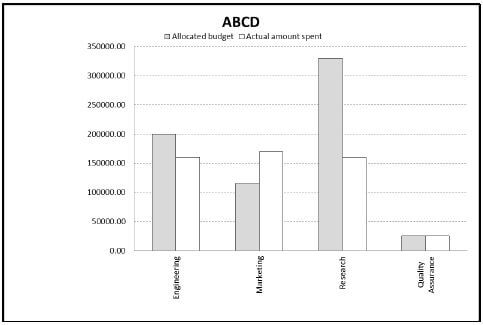
6.4.1 How many categories (series of data) are shown in this graph/chart? (1)
6.4.2 Explain the problem that exists in the Marketing department according to the graph/chart. (1)
6.4.3 Which department underspent by the largest percentage on their allocated budget? (1)
6.4.4 Suggest THREE improvements that could be made to this graph/chart to make it easier to interpret. (3) [11]
QUESTION 7: SOCIAL IMPLICATIONS
7.1 State TWO uses of AR (augmented reality). (2)
7.2 Give TWO examples of how social engineering is done. (2)
7.3 Discuss TWO benefits of using Bitcoin. (2)
7.4 A virtual private network (VPN) allows a user to remain anonymous while on the internet. Give TWO reasons why some governments are blocking VPN access for their citizens. (2)
7.5 Give TWO tips for the responsible use of social media in order to prevent offending other people. (2) [10]
QUESTION 8: SOLUTION DEVELOPMENT
8.1 What does the key symbol to the left of the database field show in the screenshot below?  (1)
(1)
8.2 After the Show/Hide feature was activated, the following is displayed in a word processing document: 
8.2.1 How did the user try to align the numbers in the screenshot above? (1)
8.2.2 Give TWO other word processing features that can be used to align the data above. (2)
8.3 Explain the purpose of a hyperlink in a document or web page. (1)
8.4 The numbers in the spreadsheet below need to be arranged from the smallest to the largest. ![]()
Describe how this can be done without re-typing each number. (2)
8.5 Consider the screenshot below.
Name the combination of spreadsheet functions that were used in the cells in column B to extract the first word from the data in the cells in column A.
NOTE: The formula in cell B1 was copied down to the rest of the cells in column B.  (2)
(2)
8.6 Draw the table represented by the HTML code below.
<table border=10>
<tr>
<td> A </td>
<td> B </td>
</tr>
<tr>
<td colspan=2> C </td>
</tr>
</table> (6) [15]
TOTAL SECTION B: 75
SECTION C: INTEGRATED SCENARIO
QUESTION 9
You are a computer specialist. The local traffic department has requested you to assist with the online administration of traffic offences.
9.1 The traffic officers have to record traffic offences at the roadside and communicate them to the traffic department.
9.1.1 What communications technology is most likely to be used to connect to the internet in this case? Motivate your answer. (2)
9.1.2 Barcodes are used on car licence disks. State TWO advantages of scanning barcodes as opposed to manually writing information down. (2)
9.1.3 Suggest a device that can be used to scan barcodes, other than barcode scanners. (1)
9.1.4 Give the term used to describe data that can be collected from offenders to uniquely identify them based on their physical features. (1)
9.2 The traffic officers would like to prevent traffic offenders from sharing information about speed traps and road blocks on social media.
9.2.1 State TWO ways in which traffic offenders can determine and share the location of a mobile speed camera after passing it. (2)
9.2.2 State TWO ways in which people try to hide social media posts from the authorities. (2)
9.2.3 While driving, your friend uses his smartphone to photograph people committing traffic offences with the aim of assisting the authorities. Why could his good intentions get him into trouble? (1)
9.3 The traffic department wants to implement an electronic filing system to establish a paperless office. There will be no need for a dedicated flatbed scanner to scan documents.
9.3.1 Explain the term dedicated device. (1)
9.3.2 Why is it possible to use certain printers for scanning? (1)
9.3.3 State TWO benefits of a paperless office. (2)
9.3.4 Suggest TWO ways in which the traffic department can make off-site backups of their data. (2)
9.3.5 The information from the documents will be captured in a database. State TWO advantages of storing data in a database. (2)
9.4 The traffic department would like to send letters to remind traffic offenders to pay their traffic fines.
9.4.1 What word processing feature can be used to create multiple personalised letters to all traffic offenders? (1)
9.4.2 State TWO ways to send electronic payment reminders using ICTs, other than using social media. (2)
9.5 Special cameras are used to monitor all traffic.
9.5.1 Name TWO types of internal storage media that can be used in the camera to store pictures and videos. (2)
9.5.2 Which camera setting affects the quality of the pictures and videos? (1) [25]
QUESTION 10
You decide to set up an employment centre to assist the unemployed people in your area to find jobs.
10.1 You want to promote the employment centre using a YouTube video.
10.1.1 Why is it not a good idea for a user to repeatedly stream a YouTube video? (1)
10.1.2 How could a user watch the video without streaming it? (1)
10.1.3 People who upload videos to YouTube always track the number of views of the videos. Give TWO reasons why one would track the number of views, other than finding out whether the video is popular or not. (2)
10.1.4 YouTube has different video resolution options to select from. Give TWO reasons for using a low resolution option when watching videos on YouTube. (2)
10.1.5 Which device would enable you to take a smartphone video of yourself without holding the smartphone in your hand? (1)
10.1.6 A computer used to edit videos has 16 GB RAM, which is the maximum amount of RAM that this computer can have. The computer is extremely slow.
Give TWO reasons with regard to hardware why this could happen. (2)
10.2 The employment centre wishes to invite companies to advertise vacancies on their website.
10.2.1 Give TWO e-mail netiquette guidelines when communicating with these companies. (2)
10.2.2 Give TWO reasons why some jobseekers cannot view certain content on the employment website. (2)
10.2.3 How can jobseekers get regular updates about vacancies without having to visit the website? (1)
10.2.4 State TWO ways in which the employment centre can stop unwanted advertisements from appearing while browsing. (2)
10.2.5 Suggest TWO ways in which jobseekers can refer to vacancies at a later stage without having to go online again. (2)
10.2.6 When viewing a website on a small screen, even maximising the browser window does not allow a user to see the full web page.
Suggest TWO ways in which this problem could be addressed. (2)
10.3 An image such as the one below will be generated for every vacancy on the website. 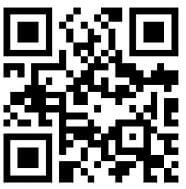
10.3.1 What is this image called? (1)
10.3.2 State the function of this image. (1)
10.3.3 You have used your smartphone to download a brochure with this type of image. State how you could wirelessly connect your smartphone to a printer in order to print the brochure. (1)
10.4 Name TWO input or output devices that could make computers accessible to visually impaired users at the centre. (2) [25]
TOTAL SECTION C: 50
GRAND TOTAL: 150
COMPUTER APPLICATION TECHNOLOGY PAPER 2 GRADE 12 MEMORANDUM - AMENDED SENIOR CERTIFICATE EXAMS PAST PAPERS AND MEMOS MAY/JUNE 2018
COMPUTER APPLICATION TECHNOLOGY
PAPER 2
GRADE 12
AMENDED SCE PAST PAPERS AND MEMOS
MAY/JUNE 2018
MEMORANDUM
SUGGESTIONS AND RECOMMENDATIONS TO MARKERS
- Revisit the questions and the marking guidelines frequently during the marking session.
- It is advisable to read the question frequently (and re-read) together with the candidate's response to check that it correlates, so that you are not misled by the candidate's statements/answers.
- Be careful not to focus on keywords or general statements, but rather read the entire answer. If in doubt, read the entire answer and then the question paper and marking guidelines. Ask yourself or your senior marker if the response could ΄fit΄ into the marking guidelines before allocating the correct marks to the candidate. For example, the marking guidelines state 'cheap' and the learner responds with 'less expensive'.
- Beware of overlapping answers to a specific question. In general, one mark is awarded per fact.
SECTION A
QUESTION 1: MULTIPLE-CHOICE QUESTION 2: MATCHING ITEMS
1.1 | B ✔ | (1) |
1.2 | D ✔ | (1) |
1.3 | B ✔ | (1) |
1.4 | A ✔ | (1) |
1.5 | C ✔ | (1) |
1.6 | A/B ✔ | (1) |
1.7 | C ✔ | (1) |
1.8 | D ✔ | (1) |
1.9 | B ✔ | (1) |
1.10 | C ✔ | (1) |
Total: [10] | ||
2.1 | L ✔ | (1) |
2.2 | O ✔ | (1) |
2.3 | S ✔ | (1) |
2.4 | M ✔ | (1) |
2.5 | K ✔ | (1) |
2.6 | R ✔ | (1) |
2.7 | T ✔ | (1) |
2.8 | F ✔ | (1) |
2.9 | H ✔ | (1) |
2.10 | A ✔ | (1) |
Total: [10] | ||
QUESTION 3: TRUE OR FALSE ITEMS
(Note to marker: In Question 3.1, 3.2, 3.4 and 3.5, accept the correct term even if false is not stated. Do not award a mark if only 'FALSE' is written down.) | ||
3.1 | FALSE, Bugs | (1) |
3.2 | FALSE, Fingerprint/Voice /Iris/Face recognition/Pattern Lock/Trusted places | (1) |
3.3 | TRUE | (1) |
3.4 | FALSE, zombie/bot | (1) |
3.5 | FALSE, The ROUND/ROUNDUP/ROUNDDOWN function | (1) |
[5] | ||
TOTAL SECTION A: [25]
SECTION B
QUESTION 4: SYSTEMS TECHNOLOGIES
4.1 |
| (1) | |
4.2 |
(Note to marker: Accept slider and date picker.) | (2) | |
4.3 |
(Note to marker: Accept format.) | (2) | |
4.4 |
(Note to marker: Accept more than one option per bullet.) | (2) | |
4.5 |
| (2) |
4.6 |
| (2) | |
4.7 |
| (2) | |
4.8 |
(Note to marker: Accept examples of passwords that display two of the above criteria.) | (2) | |
4.9 |
| (2) | |
4.10 |
(Note to marker: Accept actual services provided by the server, e.g. security, software updates, etc.) | (2) | |
4.11 |
(Note to marker: Do not accept hardware failure.) | (1) |
4.12 |
(Note to marker: Accept suitable examples, e.g. reference to medical applications.) | (2) | |
4.13 | A computer-generated (3D)/simulated world✔ that can be interacted✔ with using special devices. | (2) | |
[24] | |||
QUESTION 5: INTERNET AND NETWORK TECHNOLOGIES
5.1 | VOIP✔ | (1) | |
5.2.1 | Place the devices very close to each other/Let the devices touch each other✔ | (1) | (3) |
5.2.2 |
| (2) | |
5.3 |
| (2) | |
5.4 | Allows the user to store/add/remove products/items✔ before a transaction is completed✔ | (2) | |
5.5 |
| (2) | |
5.6 |
| (1) |
5.7 |
| (2) | |
5.8 |
| (2) | |
[15] | |||
QUESTION 6: INFORMATION MANAGEMENT
6.1 |
| (2) | |
6.2 | Export/Copy to csv/text file/another application✔ | (2) | |
6.3 | Changes to original data will be updated automatically wherever it is referenced✔ | (1) | |
6.4.1 | 2✔ | (1) | (6) |
6.4.2 | They spent too much of their budget/They overspent✔ | (1) | |
6.4.3 | Research✔ | (1) | |
6.4.4 |
| (3) | |
[11] | |||
QUESTION 7: SOCIAL IMPLICATIONS
7.1 |
| (2) | |
7.2 |
| (2) | |
7.3 |
| (2) | |
7.4 |
| (2) | |
7.5 |
| (2) | |
[10] | |||
QUESTION 8: SOLUTION DEVELOPMENT
8.1 | The field is a primary key✔ | (1) | |
8.2.1 | Used the spacebar/Spaces were used✔ | (1) | (3) |
8.2.2 |
| (2) | |
8.3 |
| (1) | |
8.4 | Sort✔ using the left to right setting/horizontally✔ | (2) | |
8.5 | Combine the LEFT/MID✔ functions with the FIND/SEARCH✔ functions to find the space | (2) | |
8.6 |
| (6) | |
[15] | |||
TOTAL SECTION B: 75
SECTION C
QUESTION 9: INTEGRATED SCENARIO
9.1.1 | 3G/LTE/4G/Cellular/Satellite✔
| (2) | (6) |
9.1.2 |
| (2) | |
9.1.3 | Smart device e.g. smartphone, tablet, phablet✔ | (1) | |
9.1.4 | Biometric data✔ | (1) | |
9.2.1 |
| (2) | (5) |
9.2.2 |
| (2) | |
9.2.3 |
| (1) | |
9.3.1 | A dedicated device has only one function✔ | (1) | |
9.3.2 | Some printers have multi-function features/Convergence of features in one device/Printer may be a multi-function device✔ | (1) |
9.3.3 |
| (2) | (8) |
9.3.4 | Use cloud storage✔ | (2) | |
9.3.5 |
| (2) | |
9.4.1 | Mail merge✔ | (1) | (3) |
9.4.2 |
| (2) | |
9.5.1 |
| (2) | (3) |
9.5.2 |
| (1) | |
[25] | |||
QUESTION 10: INTEGRATED SCENARIO
10.1.1 | • Excessive use of data/High data costs
| (1) | (9) |
10.1.2 | Download/Save the video✔ | (1) | |
10.1.3 |
| (2) | |
10.1.4 | Less data will be used✔ | (2) | |
10.1.5 |
| (1) | |
10.1.6 |
| (2) | |
10.2.1 |
| (2) | |
10.2.2 |
| (2) |
10.2.3 | Subscribe to the website/RSS-feeds✔ | (1) | (11) |
10.2.4 |
| (2) | |
10.2.5 |
| (2) | |
10.2.6 |
| (2) | |
10.3.1 | QR code✔ | (1) | (3) |
10.3.2 | QR codes are used as a link to a URL/webpage/text/file✔ | (1) | |
10.3.3 |
| (1) | |
10.4 |
| (2) | |
[25] | |||
TOTAL SECTION C: 50
GRAND TOTAL: 150
COMPUTER APPLICATION TECHNOLOGY PAPER 1 GRADE 12 MEMORANDUM - AMENDED SENIOR CERTIFICATE EXAMS PAST PAPERS AND MEMOS MAY/JUNE 2018
COMPUTER APPLICATION TECHNOLOGY
PAPER 1
GRADE 12
AMENDED SCE PAST PAPERS AND MEMOS
MAY/JUNE 2018
MEMORANDUM
IGNORE SPELLING IN ALL CASES WHERE IT WOULD NOT HAVE ANY IMPACT ON THE ANSWER.
QUESTION 1 File name: 1Artists Total Q1: 29
No. | Criteria | Maximum Mark | Candidate Mark | ||
1.1 | Margin
| 1 | 1 | ||
1.2 | Heading
| 1 1 1 | 3 | ||
1.3 | Source (Culture Trip)
| 1 1 1 | 3 | ||
1.4 | Paragraph spacing
| 1 | 1 | ||
1.5.1 | Edit citation
| 1 | 1 | ||
1.5.2 | Insert citation
| 1 | 1 | ||
1.6 | Text box
| 1 1 | 2 | ||
1.7 | Bullets
| 1 1 | 2 | ||
1.8 | Find and replace
| 1 1 | 2 | ||
1.9 | Image
| 1 1 1 1 1 | 5 | ||
1.10 | Caption
| 1 1 | 2 | ||
1.11 | Table of figures
| 1 1 | 2 | ||
1.12 | Watermark
| 1 1 1 1 | 4 | ||
Total for QUESTION 1 | [29] |
QUESTION 2 File name: 2Top15SA Total Q2: 20
No. | Criteria | Maximum Mark | Candidate Mark | ||
2.1 | Cover page
| 1 1 1 1 1 | 5 | ||
2.2 | Page numbering
| 1 1 1 | 3 | ||
2.3 | Paragraph pagination
| 1 1 | 2 | ||
2.4 | Table
| 1 1 1 1 | 4 | ||
2.5 | Table
| 2 | 2 | ||
2.6 | Page orientation
| 1 1 | 2 | ||
2.7 | Cross-reference (Figure 3: Irma Stern)
| 1 1 | 2 | ||
Total for QUESTION 2 | [20] | ||||
QUESTION 3 File name: 3Sales Total Q3: 23
- Mark the questions from the formulae and not the values/answers in the cell.
- Check against candidate's actual work (Cell references may differ, depending on the candidate's response).
- Candidate may use multiple formulae or cells as 'building blocks' to answers.
- Named ranges can be used instead of cell references.
- Any function that works consistently for the data should be accepted.
No. | Criteria | Maximum Mark | Candidate Mark | ||
Summary_Opsomming worksheet | |||||
3.1 | Row 1
| 1 | 1 | ||
3.2 | Cell K3: =AVERAGE(G3:G43)
| 1 1 | 2 | ||
3.3 | Cell K4:
| 1 2 1 1 | 5 | ||
3.4 | Cell K5:
| 1 1 1 1 | 4 | ||
3.5 | Cell H3:
| 1 1 2 3 | 7 | ||
Chart_Grafiek worksheet | |||||
3.6 |
| 1 1 1 1 | 4 | ||
Total for QUESTION 3 | [23] | ||||
QUESTION 4 File name: 4Novice Total Q4: 27
- Mark the questions from the formulae and not the values/answers in the cell.
- Check against candidate's actual work (Cell references may differ, depending on the candidate's response).
- Candidate may use multiple formulae or cells as 'building blocks' to reach answers.
- Named ranges can be used instead of cell references.
- The answers must still be correct even if changes are made to the existing data.
No. | Criteria | Maximum Mark | Candidate Mark | ||
Artist_Kunstenaar worksheet | |||||
4.1 | Row 1:
| 1 1 1 | 3 | ||
4.2 | Column D
| 1 1 | 2 | ||
4.3 | Cell F3:
| 1 1 1 1 | 4 | ||
4.4 | Cell H4:
| 1 1 1 1 1 1 | 6 | ||
4.5 | Cell K5:
| 1 1 2 1 | 5 | ||
4.6 | Cells L3:L202
| 1 | 1 | ||
4.7 | Cell M6:
| 3 | 3 | ||
4.8 | Conditional formatting: Column K
| 1 1 1 | 3 | ||
Total for QUESTION 4 | [27] |
QUESTION 5 File name: 5ArtData Total Q5: 40
No. | Criteria | Maximum Mark | Candidate Mark | |||
Table: tblArtists | ||||||
5.1.1 | Field: ID
| 1 | 1 | |||
5.1.2 | Field: Name
| 1 | 1 | |||
5.1.3 | Field: Cellnumber
| 1 | 1 | |||
5.1.4 | Field: StreetName
| 1 | 1 | |||
5.1.5 | Field: PostalCode
| 1 1 | 2 | |||
5.1.6 | Field: E-mail
| 1 | 1 | |||
5.1.7 | Field: Genre
| 1 | 1 | |||
5.1.8 | Field: ArtistCode
| 1 1 1 1 | 4 | |||
Form: frm5_2 | ||||||
5.2 |
| 1 1 1 2 | 5 | |||
Query: qry5_3 | ||||||
5.3 |
| 1 2 2 | 5 | |||
Query: qry5_4 | |||||
5.4 |
| 1 1 1 1 2 1 | 7 | ||
Query: qry5_5 | |||||
5.5 |
| 2 1 1 | 4 | ||
Report: rpt5_6 | |||||
5.6 |
| 1 1 1 2 2 | 7 | ||
Total for QUESTION 5 | [40] | ||||
QUESTION 6 File name: 6Expensive Total Q6: 19
- This question should be marked from the HTML code.
- Some attribute values do not need to be in inverted commas.
- A maximum of 1 mark will be deducted if one or more closing tags are omitted.
No. | Criteria | Maximum Mark | Candidate Mark | ||
6.1 | Title
| 1 | 1 | ||
6.2 | Font face
| 1 1 | 2 | ||
6.3 | Heading 1 and alignment
| 1 1 | 2 | ||
6.4 | Italics
| 1 | 1 | ||
6.5 | Horizontal rule
| 1 | 1 | ||
6.6 | Alternative text
| 1 1 | 2 | ||
6.7 | Unordered list
| 1 | 1 | ||
6.8 | Table
| 1 1 1 1 1 1 1 | 7 | ||
6.9 | Hyperlink
| 1 1 | 2 | ||
Closing tag(s) or triangular brackets omitted or incorrect nesting | -1 | ||||
Total for QUESTION 6 | [19] |
QUESTION 7 Total Q7: 22 File names: 7Global, 7Watercolour, 7WColour, 7ForSale
No. | Criteria | Maximum Mark | Candidate Mark | ||
7Global | |||||
7.1.1 | WordArt:
| 1 1 | 2 | ||
7.1.2 | Linked object
| 1 1 1 | 3 | ||
7.1.3 | Style: Intense Quote
| 1 1 | 2 | ||
7.1.4 | Comment
| 1 1 | 2 | ||
7Watercolour/7WColour | |||||
7.2.1 | Combining table data
| 1 1 | 2 | ||
7.2.2 | Export to pdf
| 1 1 | 2 | ||
- Allocate all marks for the correct answer.
- If the answer is incorrect, check the necessary worksheet and allocate one mark for any correct attempt to determine the answer, e.g. filter/appropriate function incorrectly used.
7ForSale | |||||
7.3.1 | Number of artworks
| 1 | 1 | ||
7.3.2 | Lithograph medium artworks
| 2 | 2 | ||
7.3.3 | Data in both the framed and unframed categories
| 2 | 2 | ||
7.3.4 | Number of unique artists on list
| 2 | 2 | ||
7.3.5 | Different mediums for 'Kentridge William'
| 2 | 2 | ||
Total for QUESTION 7 | [22] | ||||
TOTAL | 180 | ||||
CIVIL TECHNOLOGY GRADE 12 QUESTIONS - AMENDED SENIOR CERTIFICATE EXAMSPAST PAPERS AND MEMOS MAY/JUNE 2018
CIVIL TECHNOLOGY
GRADE 12
AMENDED SCE PAST PAPERS AND MEMOS
MAY/JUNE 2018
REQUIREMENTS:
- Drawing instruments
- A non-programmable calculator
- ANSWER BOOK
INSTRUCTIONS AND INFORMATION
- This question paper consists of SIX questions.
- Answer ALL the questions.
- Answer each question as a whole. Do NOT separate subsections of questions.
- Start the answer to EACH question on a NEW page.
- Do NOT write in the margins of the ANSWER BOOK.
- You may use sketches to illustrate your answers.
- Write ALL calculations and answers in the ANSWER BOOK or on the attached ANSWER SHEETS.
- Use the mark allocation as a guide to the length of your answers.
- Make drawings and sketches in pencil, fully dimensioned and neatly finished off with descriptive titles and notes to conform to the SANS/SABS Code of Practice for Building Drawings.
- For the purpose of this question paper, the size of a brick should be taken as 220 mm x 110 mm x 75 mm.
- Use your own discretion where dimensions and/or details have been omitted.
- Answer QUESTIONS 2.7, 3.5, 4.3, 5.2, 5.3, 6.1 and 6.2 on the attached ANSWER SHEETS using drawing instruments, where necessary.
- Write your CENTRE NUMBER and EXAMINATION NUMBER on every ANSWER SHEET and hand them in with your ANSWER BOOK, whether you have used them or not.
- Drawings in the question paper are NOT to scale due to electronic transfer.
- Google Images was used as the source for all photographs and pictures.
QUESTIONS
QUESTION 1: CONSTRUCTION, SAFETY AND MATERIALS
Start this question on a NEW page.
1.1 Study FIGURE 1.1 below that shows a worker drilling on a construction site and answer the questions that follow. 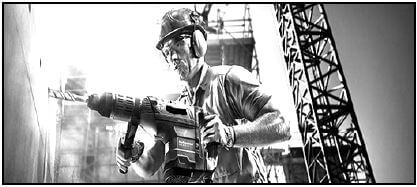
FIGURE 1.1
1.1.1 Describe the purpose of the hard hat. (1)
1.1.2 Explain how the worker can protect himself from the dust caused by the drill. (1)
1.1.3 Describe the consequences if safety equipment is not used by the worker whilst drilling. (1)
1.2 FIGURE 1.2 below shows safety equipment used for personal protection. 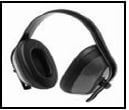
FIGURE 1.2
1.2.1 Identify the safety equipment. (1)
1.2.2 Name ONE specific place/working area where this equipment will be used. (1)
1.3 FIGURE 1.3 below shows the line diagram of a roof truss. 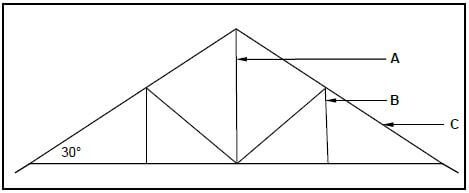
FIGURE 1.3
1.3.1 Identify the type of roof truss. (1)
1.3.2 Identify parts A to C of the roof truss. (3)
1.3.3 Motivate why the roof truss in FIGURE 1.3 cannot be covered with grass (thatch). (1)
1.3.4 Name ONE roof covering that can be used for the roof in FIGURE 1.3 if battens (38 mm x 38 mm) are used to keep the roof covering in place. (1)
1.4 Explain the difference between DPC (damp proof course) and a DPM (damp proof membrane) in terms of where it is used. (2)
1.5 Differentiate between a standard clay brick and a queen closer by means of TWO freehand two-dimensional drawings in good proportion. Draw the view of the headers only. Label EACH drawing and write down the width and height of each brick. (5)
1.6 Corrosion of steel sections can be prevented by either painting or galvanising them. Recommend ONE of the methods and explain why you recommend it. (1)
1.7 Name any TWO preservatives that can be used to preserve timber. (1)
1.8 Draw a neat sketch of a tongue and groove board used for flooring. (3)
1.9 Describe the purpose of cement in concrete. (1)
1.10 Distinguish between mass concrete and reinforced concrete. (2)
1.11 During the casting of fresh concrete many air bubbles that cause voids are trapped in the concrete. Name TWO ways in which trapped air in concrete can be removed. (1)
1.12 Explain the difference between a slump test and a cube test in terms of the purpose of each test. (2)
1.13 Name the component used to close the gap/opening between two adjacent gypsum ceiling boards. (1) [30]
QUESTION 2: ADVANCED CONSTRUCTION AND EQUIPMENT
Start this question on a NEW page.
2.1 FIGURE 2.1 below is a sketch of a precast concrete pile driven into the ground. 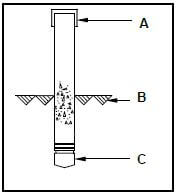
FIGURE 2.1
2.1.1 Name parts A and C. (2)
2.1.2 What does symbol B indicate? (1)
2.1.3 What equipment is used to drive this type of pile into the ground? (1)
2.1.4 Under what conditions will a pile foundation be used? (2)
2.2 Explain how you will use a transparent pipe level to transfer levels from one point to another. The pipe is already filled with water. (2)
2.3 You must lay tiles on a floor. Name any THREE tools that can be used to set out the floor for the tiles. (3)
2.4 FIGURE 2.4 below is a machine that is used in the building environment. 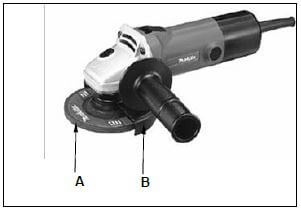
FIGURE 2.4
2.4.1 Identify the tool in FIGURE 2.4. (1)
2.4.2 Identify part A. (1)
2.4.3 Describe the function of part B. (1)
2.5 Arches are commonly used in the building industry.
2.5.1 Name the timber construction that has to be constructed to support the bricks of a semi-circular arch. (1)
2.5.2 Name the brick that is in the middle of the semi-circular arch. (1)
2.6 FIGURE 2.6 below shows a concrete beam with defects caused by forces acting on them. Name the types of forces that are responsible for the defects at A en B. 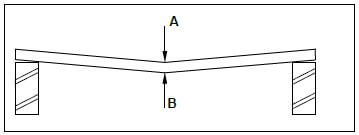
FIGURE 2.6 (2)
2.7 FIGURE 2.7 on the ANSWER SHEET shows an incomplete sectional view of a cavity wall.
Use ANSWER SHEET 2.7 to complete the cavity wall by drawing the following in good proportion:
- Six brick courses above the existing two courses (2)
- Mortar between brickwork (1)
- Symbol for concrete in the cavity between the walls (1)
- Symbol for concrete in the foundation (1)
- The symbol for back filling on one side only (1)
- The damp proof between the walls and the cavity (2)
- The weep hole (1)
- One wall tie (1)
2.8 A garage needs to be converted to a bachelor's flat. Due to limited time and the cost of labour, brick walls are not considered. Name a type of light-weight wall that can be used to divide the garage into rooms. (1)
2.9 Describe ONE disadvantage of the type of wall named in QUESTION 2.8. (1)
2.10 FIGURE 2.10 below shows an incomplete sectional view of a reinforced beam. 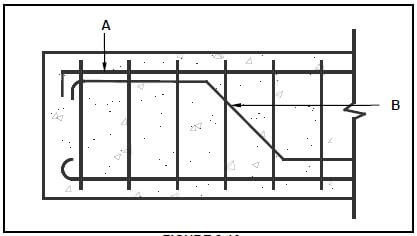
FIGURE 2.10
2.10.1 Identify A and B. (2)
2.10.2 Name ONE negative consequence if there is no reinforcement in concrete. (1)
2.10.3 State ONE function of stirrups. (1)
2.11 FIGURE 2.11 below shows formwork for a round column. 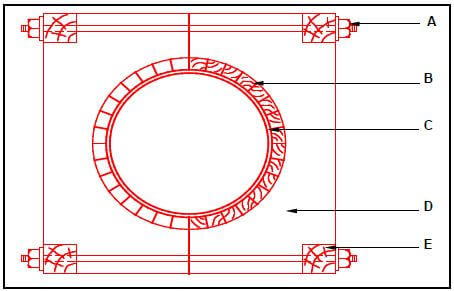
FIGURE 2.11
Identify A to E. (5)
2.12 Rearrange the stages below in the correct order to erect the rib and block floor. Write down only the letters (A–C) in the correct order in the ANSWER BOOK.
- Place reinforcing on top of hollow blocks.
- Pack all the hollow blocks between the ribs.
- Place ribs on supporting walls. (1) [40]
QUESTION 3: CIVIL SERVICES
Start this question on a NEW page.
3.1 Choose a description from COLUMN B that matches an item in COLUMN A. Write only the letter (A–H) next to the question numbers (3.1.1 to 3.1.6) in the ANSWER BOOK, e.g. 3.1.7 F.
COLUMN A | COLUMN B |
3.1.1 Pressure reducing valve |
|
3.2 Where would you install a water trap? (1)
3.3 Name ONE type of water trap that is used at a hand wash basin. (1)
3.4 Draw the following electrical symbols:
3.4.1 Socket outlet (2)
3.4.2 Two-way switch (2)
3.4.3 Light wall mounted (2)
3.5 On ANSWER SHEET 3.5 complete the drawing of a sectional view of a septic tank and show the following on your drawing:
- External walls with plaster and holes
- Inner wall with hole and plaster
- Inlet pipe with T-junction
- Outlet pipe with T-junction
- Liquid level
- Concrete cover with manholes (11)
3.6 In the absence of piped water from the municipality, name ONE other source of fresh water that is suitable for human consumption. (1)
3.7 Describe the main function of a storm-water system. (1)
3.8 Coal is the primary energy source used in South Africa to generate electricity. Name ONE other source from which electricity can be generated. (1)
3.9 Describe ONE advantage of a solar geyser. (1)
3.10 Describe ONE possible way in which a consumer could reduce electricity consumption in a home. (1) [30]
QUESTION 4: QUANTITIES, MATERIALS AND JOINING
Start this question on a NEW page.
4.1 Various options are given as possible answers to the following questions. Choose the answer and write only the letter (A–D) next to the question numbers (4.1.1 to 4.1.5) in the ANSWER BOOK, e.g. 4.1.6 C.
4.1.1 … are used to connect steel roof parts, steel columns and in situ timber trusses.
- Steel nails
- Bolts and nuts
- Dry-wall screws
- Cavity anchor (1)
4.1.2 A/An … is a type of nail used to attach ceiling boards to the brandering.
- wire nail
- cut nail
- clout nail
- oval wire nail (1)
4.1.3 … is used to join copper pipes.
- Brazing rod
- Welding rod
- Grease
- Solder (1)
4.1.4 … are used to join the members of a timber roof truss to one another.
- Gang nails/A connector plate
- Clout nails
- Rawl bolts
- Screws (1)
4.1.5 … can be used to join a roof truss to brickwork.
- Bolt and nut
- Sleeve anchor
- Hoop iron
- All the above-mentioned (1)
4.2 FIGURE 4.2 below shows the front view of a two-panel door. Study the drawing and complete the incomplete cutting list below. Write only the answer next to the question numbers (4.2.1 to 4.2.7) in the ANSWER BOOK. 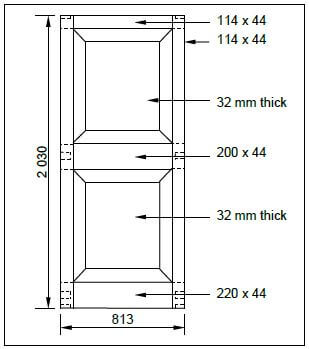
FIGURE 4.2 (7)
MEMBER | QUANTITY | UNIT | LENGTH | WIDTH | THICKNESS | MATERIAL |
Stile | 2 | mm | 4.2.1 | 114 | 44 | Saligna |
Top rail | 4.2.2 | mm | 813 | 114 | 4.2.3 | Saligna |
Lock rail | 1 | mm | 4.2.4 | 4.2.5 | 44 | Saligna |
Raised and fielded panel | 2 | mm | 768 | 612 | 4.2.6 | Saligna |
Bottom rail | 1 | mm | 813 | 4.2.7 | 44 | Saligna |
4.3 FIGURE 4.3 below shows the floor plan of a garage with a garage door, a side door and a window. 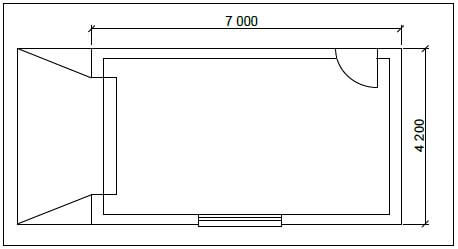
FIGURE 4.3
SPECIFICATIONS:
- The superstructure is a one-brick wall, 220 mm wide and 2 600 mm high.
- The side door opening is 2 100 mm high x 900 mm wide.
- The garage door is 2 400 mm wide x 2 100 mm high.
- The window opening is 1 500 mm wide x 450 mm high.
Use ANSWER SHEET 4.3 and calculate the total area of the walls for the superstructure that needs to be built after deducting all the openings. (18) [30]
QUESTION 5: APPLIED MECHANICS
Start this question on a NEW page.
5.1 FIGURE 5.1 shows a shaped lamina. All dimensions are in millimetres. Study the lamina and calculate the centroid of the lamina form A-A.
HINT: Use the formulae on the FORMULA SHEET. 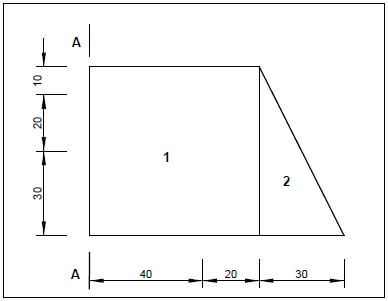
FIGURE 5.1 (9)
5.2 ANSWER SHEET 5.2 shows a diagram of a cantilever frame. Use ANSWER SHEET 5.2 to answer the following questions.
5.2.1 Name DIAGRAM A. (1)
5.2.2 On ANSWER SHEET 5.2, develop and draw a diagram to determine graphically the nature of the forces in each member (part) of the cantilever frame. Use scale 1 mm = 1 N. (6)
5.2.3 Use the information in the diagrams and complete the table on ANSWER SHEET 5.2. (3)
5.3 FIGURE 5.3 shows the space diagram of a beam with a span of 8 metres with two point loads and a uniformly distributed load. Study the diagram and answer the questions that follow. 
FIGURE 5.3
5.3.1 Convert the uniformly distributed load to a point load and write down the value of the converted point load. (1)
5.3.2 Determine the distance of the converted uniformly distributed load that is now a point load, from RR. (1)
5.3.3 Determine the distance of the 4 N point load, from RL. (1)
5.3.4 The value of the shear forces at A = 15 N, B = 7 N, D = -9 N, D1 = -13 N and E = 0 N. Use the available information and draw the shear force diagram on ANSWER SHEET 5.3. Use a scale of 2 mm = 1 N. (8) [30]
QUESTION 6: GRAPHICS AND COMMUNICATION
6.1 FIGURE 6.1 below illustrates a detailed sectional view of the foot of a king post roof truss. Study the drawing and complete the table on ANSWER SHEET 6.1. 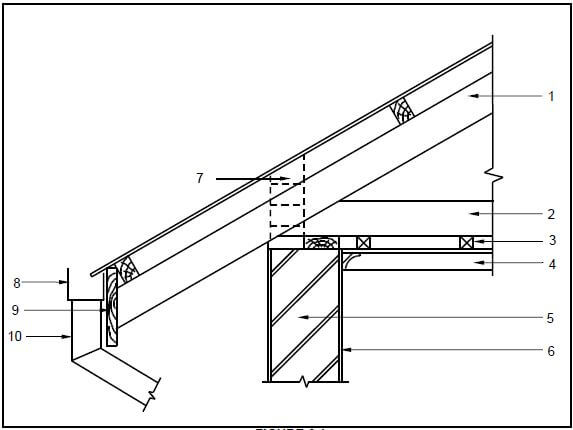
FIGURE 6.1
6.2 FIGURE 6.2 below shows the floor plan of a two-bedroom house. 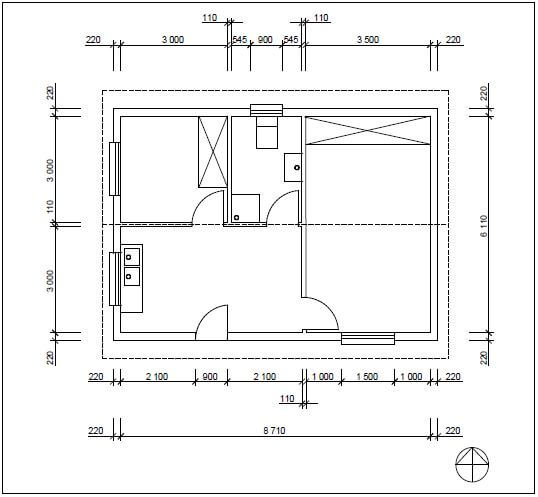
FIGURE 6.2
6.2.1 Study FIGURE 6.2 and develop and draw, on ANSWER SHEET 6.2, to scale 1 : 50, the SOUTH ELEVATION of the building. Use the specifications below.
(Use the assessment criteria on ANSWER SHEET 6.2 as a guideline for your drawing).
SPECIFICATIONS:
- The height between the natural ground level and the top level of the floor slab is 300 mm.
- The height between the floor slab and the underside of the wall plate is 2 600 mm.
- The roof is covered with galvanised roof sheeting with a 228 mm wide fascia board.
- Ridge capping is 100 mm high.
- Rainwater downpipes are 75 mm in diameter and 100 mm square gutters are used.
- One rainwater downpipe must be placed on each side the of the roof.
- The eaves overhang is 500 mm and the verge overhang is 300 mm.
- The door opening is 2 100 mm high and 900 mm wide.
- The door step is 150 mm high.
- The building has a gable roof with a pitch of 30°.
The following must also be shown on the drawing:
- The method used to determine the roof height
- Windows sills
WINDOW SCHEDULE | |||
Window 1(W1) | Window 2(W2) | ||
 | |||
Width | Height | Width | Height |
1 500 mm | 1 200 mm | 900 mm | 600 mm |
THREE marks will be allocated for the application of scale.
Start your drawing from corner A as indicated on ANSWER SHEET 6.2. (25) [40]
TOTAL: 200
CENTRE NUMBER: |
EXAMINATION NUMBER: |
ANSWER SHEET 2.7 
FIGURE 2.7
ASSESSMENT CRITERIA | MARK | CANDIDATE'S MARK |
Six brick courses above the two existing courses | 2 | |
Mortar between brickwork | 1 | |
Symbol for concrete in the cavity between the walls | 1 | |
Symbol for concrete in the foundation | 1 | |
The symbol for back filling on one side only | 1 | |
The damp-proof course between the walls and the cavity | 2 | |
The weep hole | 1 | |
One wall tie | 1 | |
TOTAL: | 10 |
CENTRE NUMBER: |
EXAMINATION NUMBER: |
ANSWER SHEET 3.5
ASSESSMENT CRITERIA | MARK | CANDIDATE'S MARK |
External walls with plaster and holes | 3 | |
Inner wall with hole and plaster | 2 | |
Inlet pipe with T-junction | 2 | |
Outlet pipe with T-junction | 2 | |
Liquid level | 1 | |
Concrete cover with manholes | 1 | |
TOTAL: | 11 |
CENTRE NUMBER: |
EXAMINATION NUMBER: |
ANSWER SHEET 4.3
Complete your answers in the spaces indicated with ... and .... .
A | B | C | D |
Centre line: Superstructure | |||
2 / … = … | |||
2 / … = … | |||
Total = … | |||
Minus 4 / … = … | |||
= … | |||
1/ | … | Area of walls for superstructure: | |
… | … | ||
1/ | … | Area of side door: | |
… | … | ||
1/ | … | Area of garage door: | |
… | … | ||
1/ | … | Area of window: | |
… | … | ||
Total area of wall after deductions: | |||
= … … … … | |||
= … | |||
(18) |
CENTRE NUMBER: |
EXAMINATION NUMBER: |
ANSWER SHEET 5.2
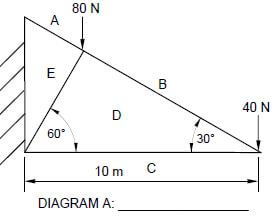 (1)
(1)
![]() (6)
(6)
DIAGRAM A IS NOT ACCORDING TO SCALE
MEMBER | NATURE |
AE | |
BD | |
CD | STRUT |
DE |
Tolerance of 1 N on both sides (3)
CENTRE NUMBER: |
EXAMINATION NUMBER: |
ANSWER SHEET 5.3 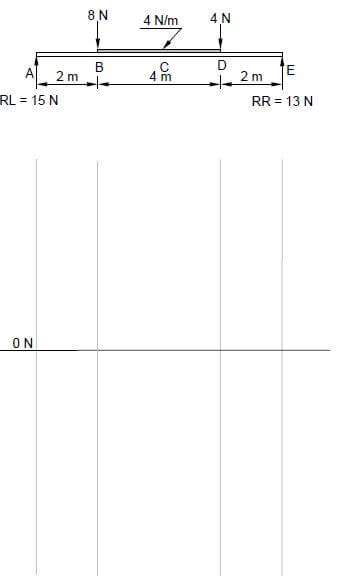
ASSESSMENT CRITERIA | MARKS | CANDIDATE'S MARK |
Correct shape of shear force diagram | 1 | |
Value of shear forces correctly measured | 5 | |
Horizontal lines indicated | 2 | |
TOTAL | 8 |
CENTRE NUMBER: |
EXAMINATION NUMBER: |
ANSWER SHEET 6.1
NO. | QUESTIONS | ANSWERS | MARKS |
1. | Identify the type of eave construction used in the drawing. | 1 | |
2. | State the minimum pitch (slope) of number 1, if galvanised roof sheeting is used. | 1 | |
3. | Identify number 2. | 1 | |
4. | State the standard dimension of number 3. | 1 | |
5. | State the purpose of number 4. | 1 | |
6. | Name the timber that is shown on top of the external wall marked number 5. | 1 | |
7. | Draw the drawing symbol for number 6 in the next column. | 2 | |
8. | Explain the purpose of number 7. | 1 | |
9. | Name ONE material that can be used for number 8. | 1 | |
10. | Identify number 9. | 1 | |
11. | Identify number 10. | 1 | |
12. | Draw a neat freehand line diagram of a fink or a W roof truss in the next column. | 3 | |
TOTAL: | 15 |
CENTRE NUMBER: | |||||||||||||
EXAMINATION NUMBER: |
ANSWER SHEET 6.2 A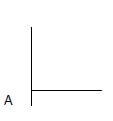
| ASSESMENT CRITERIA | MARKS | CANDIDATES MARK |
External walls | 2 | |
NGL(correctly drawn) | 1 | |
FFL(correctly drawn) | 1 | |
Window | 1 | |
Window sill | 1 | |
Door opening | 1 | |
Step | 1 | |
Fascia board | 1 | |
Rainwater downpipe | 1 | |
Roof (correctly drawn) | 2 | |
Gutter | 1 | |
Ridge capping | 1 | |
Determining roof height | 4 | |
Any FOUR labels | 4 | |
Application of scale One or two incorrect = 3 Three or four incorrect = 2 More than five incorrect = 1 No measurement correct = 0 | 3 | |
TOTAL | 25 |
FORMULA SHEET
IMPORTANT ABBREVIATIONS
SYMBOL | DESCRIPTION | SYMBOL | DESCRIPTION | SYMBOL | DESCRIPTION |
c | Centroid | b | Breadth/Width | r | Radius |
ℓ | Length | s | Side | A | Area |
FORMULAE
| AREA OF | FORMULA (in words) | FORMULA (in symbols) | FORMULA FOR THE POSITION OF CENTROIDS | |
| X-axis | Y-axis | |||
| Square | side x side | s x s | s 2 | s 2 |
| Rectangle | length x breadth | ℓ x b | ℓ 2 | b 2 |
| Right-angled triangle | ½ x base x height | ½b x h | b 3 | h 3 |
| Equilateral triangle/ Isosceles triangle | ½ x base x height | ½b x h | b 2 | h 3 |
Position of centroid = (A1 x d) ± (A2 x d)
Total area
OR
Y = ΣAy
ΣA
OR
X = ΣAx
ΣA
CIVIL TECHNOLOGY GRADE 12 MEMORANDUM - AMENDED SENIOR CERTIFICATE EXAMS PAST PAPERS AND MEMOS MAY/JUNE 2018
CIVIL TECHNOLOGY
GRADE 12
AMENDED SCE PAST PAPERS AND MEMOS
MAY/JUNE 2018
MEMORANDUM
QUESTION 1: CONSTRUCTION, SAFETY AND MATERIAL
1.1
1.1.1 A hard hat will:
- protect the worker from any head injury. ✔
- protect the worker from falling objects from above.
ANY ONE OF THE ABOVE OR ANY OTHER ACCEPTABLE ANSWER (1)
1.1.2 The worker can wear a dust mask/respiratory mask/gas mask/ protective overall. ✔ (1)
1.1.3 If the worker does not use the safety equipment:
- His/Her eyes can be damaged by the dust ✔
- Debris can get into his/her eyes
- Any part of his/her body can be injured if he/she is not wearing a protective overall.
- Hearing can be damaged if ear protection is not used
- Dust can be inhaled
ANY ONE OF THE ABOVE OR ANY OTHER ACCEPTABLE ANSWER (1)
1.2
1.2.1 Ear muffs ✔ (1)
1.2.2 In a working area where machine and equipment makes loud noises/sounds. ✔
ANY OTHER ACCEPTABLE ANSWER (1)
1.3
1.3.1 SA or Howe roof truss ✔ (1)
1.3.2
A – King post ✔
B – Queen post ✔
C – Rafter ✔ (3)
1.3.3 The slope/gradient of a roof truss used for a thatch roof must be 45˚ and the roof truss in FIGURE 1.3 has a slope of 30°.✔
ANY ONE OF THE ABOVE (1)
1.3.4
- Concrete tiles ✔
- Clay tiles
- Slate tiles
ANY ONE OR OTHER ACCEPTABLE ANSWER (1)
1.4
- DPC is used between the concrete floor and the wall between courses of brickwork. ✔
- DPM is used under a concrete floor to cover the whole area of a room or a building or as roof underlay. ✔ (2)
1.5 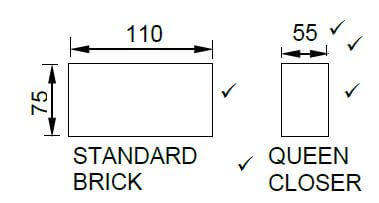 (5)
(5)
ASSESSMENTCRITERIA | MARK | CANDIDATE'S MARK |
Correctness of elevations | 2 | |
Labelling of views | 1 | |
Correct dimension lines and | 1 | |
Width of queen closer | 1 | |
TOTAL: | 5 |
1.6
- Galvanising is more expensive than painting but lasts longer than painting✔
OR - Painting is cheaper than galvanising and gives a wide variety of colours and surface finishing's.
ANY ONE OF THE ABOVE (1)
1.7
- Varnish ✔
- Oil
- Wax
- Coal tar creosote
- Paint
- Poisonous chemical salts (water and soluble salts)
- Organic compounds
ANY ONE OF THE ABOVE (1)
1.8  (3)
(3)
ASSESSMENTCRITERIA | MARK | CANDIDATE'S MARK |
Tongue(can be in the middle) | 1 | |
Groove(can be in the middle) | 1 | |
Board | 1 | |
TOTAL: | 3 |
1.9 Cement binds the ingredients of concrete together. ✔ (1)
1.10
- Mass concrete – is a volume of concrete that do not have any reinforcing✔
- Reinforced concrete – is concrete that is reinforced with steel rods to strengthen the structure✔ (2)
1.11
- Compacting by hand (rodding and spading) ✔
- Compacting through vibration (Mechanical vibrator)
ANY ONE OF THE ABOVE (1)
1.12
- A slump test is used to test workability/consistency of concrete. ✔
- A cube test is used to test compressive/crushing strength of concrete. ✔ (2)
1.13
- Cover strip/H-strip/Decorative grid strips ✔
- Jointing /ceiling tape/Gauze
- Jointing compound (rhinolyte)
ANY ONE OF THE ABOVE
QUESTION 2: ADVANCED CONSTRUCTION AND EQUIPMENT
2.1
2.1.1
- A – Steel capping ✔
- C – Steel tip ✔ (2)
2.1.2 Undisturbed earth ✔ (1)
2.1.3 A drop hammer ✔ (1)
2.1.4 Pre-cast concrete piles can be used when:
- The soil is not stable/soft ✔
- Water content of soil is high ✔
- There's a highwater table
- Subsoil is subject to movement
- Filling materials are not sufficiently compacted
ANY TWO OF THE ABOVE OR ANY OTHER ACCEPTABLE ANSWER (2)
2.2
- Bring the water level in the one side of the transparent pipe in line with the first level. ✔
- Take the other end of the pipe to the other position where the level must be transferred, maintaining the first level and make a mark next to the water level at this point. ✔ (2)
2.3
- Tape measure ✔
- Chalk line ✔
- Builders line ✔
- Builders square
- Straight edge
- Spirit level
ANY THREE OF THE ABOVE OR ANY OTHER ACCEPTABLE ANSWER (3)
2.4
2.4.1 Angle grinder ✔ (1)
2.4.2 Grinding/cutting disc ✔ (1)
2.4.3
- The safety guard protects the worker against sparks or debris from discs and materials. ✔
- The safety guard protects the body parts of the worker against the rotating blade.
ANY ONE OF THE ABOVE (1)
2.5
2.5.1
- Centre/Turning piece/Profile ✔ (1)
2.5.2
- Key brick ✔ (1)
2.6
- A – Compression force ✔
- B – Tensile force ✔ (2)
2.7 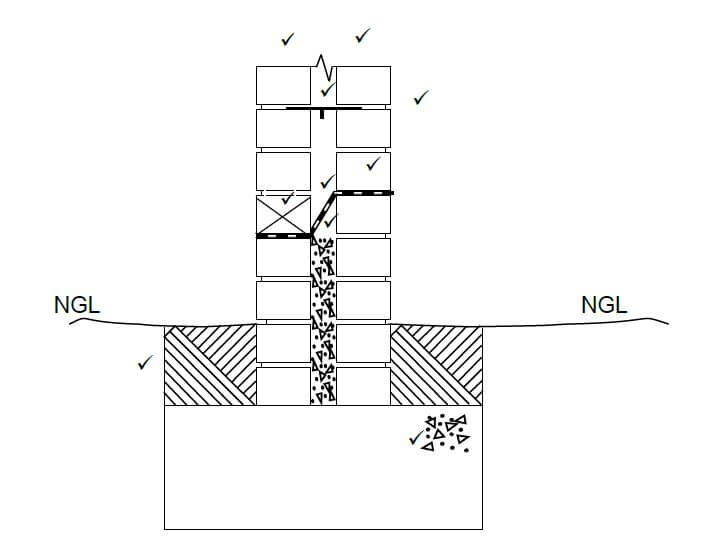 (10)
(10)
ASSESSMENTCRITERIA | MARK | CANDIDATE'S MARK |
6 Courses of bricks above the two existing courses | 2 | |
Mortar between brickwork | 1 | |
Symbol for concrete in the cavity between the walls | 1 | |
The symbol for concrete in the foundation | 1 | |
The symbol for back filling on one side only | 1 | |
The damp proof between the walls and the cavity | 2 | |
The weep hole | 1 | |
One wall tie | 1 | |
TOTAL: | 10 |
2.8 Dry wall ✔ (1)
2.9 Disadvantages of drywalls:
- They are less soundproof than brickwork. ✔
- They are less fireproof that brickwork.
- Drywalls must be joined together or attached to existing walls, to ensure sturdiness.
- Drywalls cannot carry heavy loads.
ANY ONE OF THE ABOVE (1)
2.10
2.10.1
- A - Anchor bar ✔
- B - Shear bar ✔ (2)
2.10.2 Structural failure will occur ✔ (1)
2.10.3
- To keep the main or anchor bars together. ✔
- Helps to resist shear stress
ANY ONE OF THE ABOVE (1)
2.11
A - Threaded rods and nuts✔
B – Laggings ✔
C – Lining✔
D – Collar ✔
E - Vertical clamps✔ (5)
2.12 C, B, A (1) [40]
QUESTION 3: CIVIL SERVICES
3.1 3.1.1 E ✔ (1)
3.1.2 G ✔ (1)
3.1.3 D ✔ (1)
3.1.4 F ✔ (1)
3.1.5 C ✔ (1)
3.1.6 B ✔ (1)
3.2 A water trap is installed:
- under sinks ✔
- baths
- toilets
- at a gully
- at a shower
ANY ONE OF THE ABOVE (1)
3.3 P trap or S trap or Bottle trap ✔ (1)
3.4
3.4.1  ✔✔ (2)
✔✔ (2)
3.4.2  ✔✔ (2)
✔✔ (2)
3.4.3  ✔✔ (2)
✔✔ (2)
3.5 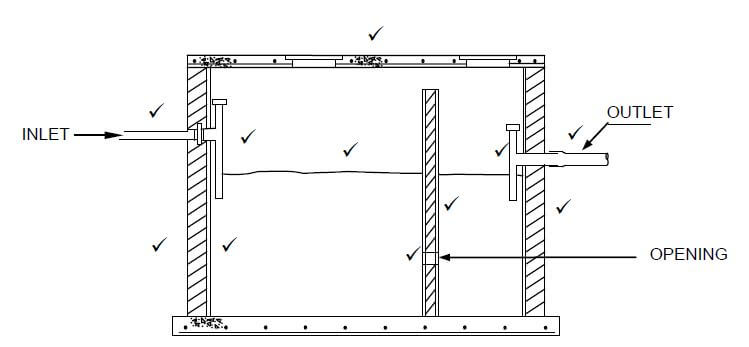 (11)
(11)
ASSESSMENT CRITERIA | MARK | CANDIDATE'S MARK |
External walls with plaster and holes | 3 | |
Inner wall with hole and plaster | 2 | |
Inlet pipe with T-junction | 2 | |
Outlet pipe with T-junction | 2 | |
Liquid level | 1 | |
Concrete cover with manholes | 1 | |
TOTAL: | 11 |
3.6
- Boreholes ✔
- Wells
- Rain water
- Snow
- Rivers
- Desalination
ANY ONE OF THE ABOVE OR ANY OTHER ACCEPTABLE ANSWER (1)
3.7 Storm water systems are used to carry storm water to rivers or low-lying dams. ✔ OR ANY OTHER ACCEPTABLE ANSWER (1)
3.8
- Solar energy ✔
- Nuclear power
- Hydro electricity
- Wind
- Natural gas
- Generator
- Inverter
ANY ONE OF THE ABOVE (1)
3.9
- Solar geysers are environmentally friendly. ✔
- Solar geysers can be used in areas where no electricity is available.
- Hot water is available at a very low cost once the installation cost has been covered.
ANY ONE OF THE ABOVE OR ANY OTHER ACCEPTABLE ANSWER (1)
3.10
- Using solar power as an alternative source of power. ✔
- Using appliances only when necessary.
- Using of low energy or LED light bulbs.
- Switch of lights in rooms that are not in use.
- Shower for shorter periods to prevent over use of geyser.
- Boil only the required quantity of water for a purpose.
- Use a geyser timer
- Use of gas
ANY ONE OF THE ABOVE OR ANY OTHER ACCEPTABLE ANSWER (1) [30]
QUESTION 4: QUANTITIES, MATERIALS AND JOINING
4.1
4.1.1 B ✔ (1)
4.1.2 C ✔ (1)
4.1.3 D ✔ (1)
4.1.4 A ✔ (1)
4.1.5 C ✔ (1)
4.2
4.2.1 2 030/2 030 mm ✔ (1)
4.2.2 1 ✔ (1)
4.2.3 44/44 mm ✔ (1)
4.2.4 813/813 mm ✔ (1)
4.2.5 200/200 mm ✔ (1)
4.2.6 32/32 mm ✔ (1)
4.2.7 220/220 mm ✔ (1)
A | B | C | D |
Centre line: Superstructure | |||
2/ 7 000 mm = 14 000 mm ✔ | |||
2/ 4 200 mm = 8 400 mm ✔ | |||
TOTAL: = 22 400 mm | |||
Minus 4/ 220 = 880 mm ✔ | |||
= 21 520 mm ✔ (4) | |||
1/ | 21,52 ✔ | Area of walls for superstructure | |
2,6 ✔ | 55,95 m² ✔ | (3) | |
1/ | 2.1 ✔ | Area of side door | |
0,9 ✔ | 1,89 m² ✔ | (3) | |
1/ | 2,4 ✔ | Area of garage door | |
2,1 ✔ | 5,04 m²✔ | (3) | |
1/ | 1,5 ✔ | Area of window | |
0,45 ✔ | 0,68 m²✔ | (3) | |
Total area of wall after deductions | |||
= 55,95 m²- 1,89 m² - 5,04 m² – 0,68 m² ✔ | |||
= 48,34 m² ✔ (2) | |||
(18) |
[30]
QUESTION 5: APPLIED MECHANICS 5.1
(A1 x d) + (A2 x d)
Total area
✔ ✔ ✔ ✔
= (3 600 mm² x 30 mm) + (900 mm² x 70 mm)
4 500 mm² ✔
= 108 000 mm³ + 63 000 mm³ ✔
4 500 mm²
= 171 000 mm³
4 500 mm² ✔
= 38 ✔ mm OR
Part | Area | X | AX |
1 | 60 mm x 60 mm = 3 600 mm² ✔ | 30 mm ✔ | 108 000 mm³ |
2 | 15 x 60 = 900 mm² ✔ | 70 mm ✔ | 63 000 mm³ |
∑ | 4 500 mm² ✔ | 171 000 mm³ |
X = ∑Ax
∑A
= 171 000 mm³ ✔
4 500 mm² ✔
= 38 mm ✔ ✔ (9)
5.2 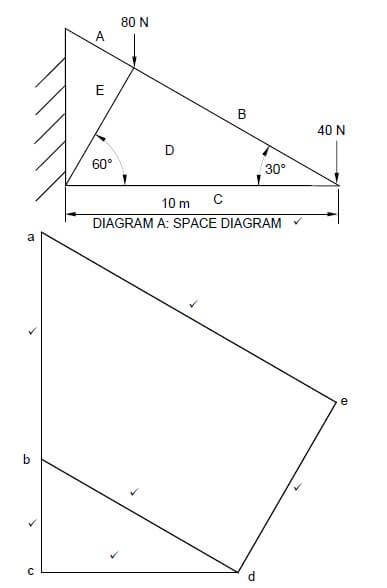 (1)
(1)
(6)
NOT ACCORDING TO SCALE
USE A MASK TO MARK THIS QUESTION
MEMBER | NATURE |
AE | Tie ✔ |
BD | Tie ✔ |
CD | Strut |
DE | Strut ✔ |
Tolerance of 1 N to either side. (3)
5.3
5.3.1 16 N ✔ (1)
5.3.2 4 m ✔ (1)
5.3.3 6 m ✔ (1)
5.3.4 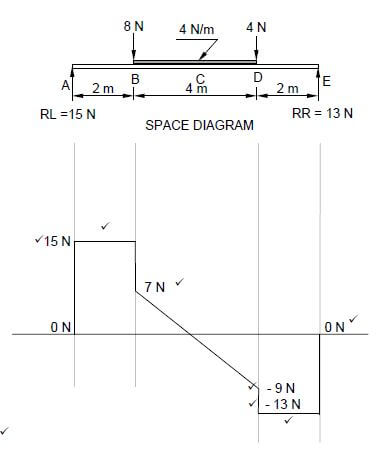 (8)
(8)
Correct shape ✔✔
SHEAR FORCE DIAGRAM
USE A MASK TO MARK THIS QUESTION
ASSESSMENT CRITERIA | MARKS | CANDIDATE'S MARK |
Correct shape of shear force diagram | 1 | |
Value of shear forces correctly measured and indicated | 5 | |
Horizontal lines indicated | 2 | |
TOTAL | 8 |
If the drawing is not drawn to the correct scale, penalise the candidate with 1 mark. [30]
QUESTION 6: GRAPHICS AND COMMUNICATION
CENTRE NUMBER: |
EXAMINATION NUMBER: |
ANSWER SHEET 6.1
NO. | QUESTIONS | ANSWERS | MARKS |
1 | Identify the type of eave construction used in the drawing. | Open eave | 1 |
2 | State the minimum pitch (slope) of number 1, if galvanised roof sheeting is used. | 5° - 10° | 1 |
3 | Identify number 2. | Tie-beam | 1 |
4 | State the standard dimension of number 3. | 38 mm x 38 mm | 1 |
5 | State the purpose of number 4. | To cover the opening between the wall and the ceiling. | 1 |
6 | Name the timber that is shown on top of the external wall marked number 5. | Wall plate | 1 |
7 | Draw the drawing symbol for number 6 in the next column. | 2 | |
8 | Explain the purpose of number 7. | To prevent dust, insects, rodents, wind and birds to enter the building | 1 |
9 | Name ONE material that can be used for number 8. | PVC, aluminium, galvanised sheet metal. | 1 |
10 | Identify number 9. | Fascia board | 1 |
11 | Identify number 10. | Down pipe | 1 |
12 | Draw a neat freehand line diagram of a Fink or W roof truss in the next column. |  | 3 |
TOTAL: | 15 |
CENTRE NUMBER: |
ASSESSMENT CRITERIA | MARKS | CANDIDATES MARK |
External walls | 2 | |
NGL (correctly drawn) | 1 | |
FFL (correctly drawn) | 1 | |
Window | 1 | |
Window sill | 1 | |
Door opening | 1 | |
Step | 1 | |
Fascia board | 1 | |
Rain-water down pipe | 1 | |
Roof (correctly drawn) | 2 | |
Gutter | 1 | |
Ridge capping | 1 | |
Determining roof height | 4 | |
Any FOUR labels | 4 | |
Application of scale One or two incorrect = 3 Three or four incorrect = 2 More than five incorrect = 1 No measurement correct = 0 | 3 | |
TOTAL | 25 |
EXAMINATION NUMBER: |
ANSWER SHEET 6.2 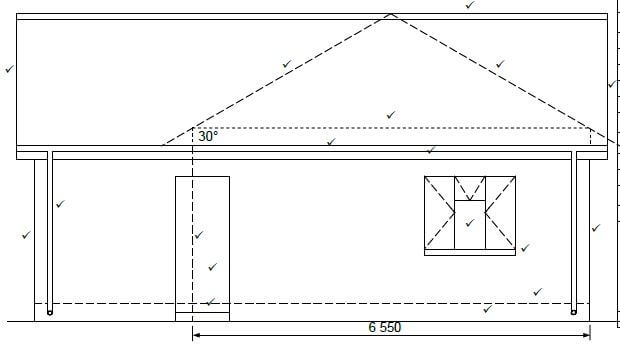
NOT TO SCALE: USE A MASK TO MARK THIS QUESTION
- Application of scale ✔ ✔ ✔
- Any four labels ✔ ✔ ✔ ✔
BUSINESS STUDIES GRADE 12 QUESTIONS - AMENDED SENIOR CERTIFICATE EXAMS PAST PAPERS AND MEMOS MAY/JUNE 2018
BUSINESS STUDIES
GRADE 12
AMENDED SCE PAST PAPERS AND MEMOS
MAY/JUNE 2018
INSTRUCTIONS AND INFORMATION
Read the following instructions carefully before answering the questions.
- This question paper consists of THREE sections and covers all FOUR main topics.
SECTION A: COMPULSORY
SECTION B: Consists of FIVE questions
Answer any THREE of the five questions in this section.
SECTION C: Consists of FOUR questions
Answer any TWO of the four questions in this section. - Read the instructions for each question carefully and take particular note of what is required.
- Number the answers correctly according to the numbering system used in this question paper. NO marks will be awarded for answers that are numbered incorrectly.
- Except where other instructions are given, answers must be in full sentences.
- Use the mark allocation and nature of each question to determine the length and depth of an answer.
- Use the table below as a guide for mark and time allocation when answering each question.
SECTION | QUESTION | MARKS | TIME (minutes) |
A: Objective-type questions COMPULSORY | 1 | 40 | 30 |
B: FIVE direct/indirect-type questions | 2 | 60 | 30 |
3 | 60 | 30 | |
4 | 60 | 30 | |
5 | 60 | 30 | |
6 | 60 | 30 | |
C: FOUR essay-type questions | 7 | 40 | 30 |
8 | 40 | 30 | |
9 | 40 | 30 | |
10 | 40 | 30 | |
TOTAL | 300 | 180 |
- Begin the answer to EACH question on a NEW page, e.g. QUESTION 1 – new page, QUESTION 2 – new page, etc.
- You may use a non-programmable calculator.
- Write neatly and legibly.
QUESTIONS
SECTION A (COMPULSORY)
QUESTION 1
1.1 Various options are provided as possible answers to the following questions. Choose the answer and write only the letter (A–D) next to the question numbers (1.1.1 to 1.1.10) in the ANSWER BOOK, e.g. 1.1.11 B.
1.1.1 This Act regulates the implementation of affirmative action when businesses make new appointments:
- Consumer Protection Act, 2008 (Act 68 of 2008)
- Employment Equity Act, 1998 ( Act 55 of 1998)
- Broad-Based Black Economic Empowerment Act, 2003 (Act 53 of 2003)
- Labour Relations Act, 1995 (Act 66 of 1995)
1.1.2 Yashika Supermarket has … control over challenges related to its vision and mission statement.
- full
- no
- limited
- little
1.1.3 It is compulsory for … to hold an annual general meeting for its shareholders.
- Shark Tale General Dealer (Pty) Ltd
- Shrek Building Appliances CC
- Incredible Toy Store Ltd
- Healthy Living NPC
1.1.4 This aspect should be considered when designing a multimedia presentation:
- Prepare for the feedback session
- Cover a large amount of information
- Keep eye contact with the audience
- Choose relevant images
1.1.5 Thrums Traders insured their building for R80 000. The actual value of the building is R100 000. Damages caused by fire amounted to R50 000. What will be the compensation for the loss?
- R100 000
- R80 000
- R62 500
- R40 000
1.1.6 Businesses use team dynamics theories to …
- promote total satisfaction.
- allocate tasks according to the roles of team members.
- allocate tasks to team members with similar personalities.
- encourage competition within teams.
1.1.7 When resolving differences between employees in the workplace, management needs to …
- dismiss the affected worker.
- shift the blame.
- address the causes of conflict.
- transfer the difficult worker.
1.1.8 The process a senior manager uses to choose the best solution, is known as…
- problem solving.
- routine thinking.
- decision making.
- brainstorming.
1.1.9 A framework that businesses use to manage key processes to maintain good standards:
- Quality control
- Quality management system
- Quality management
- Quality performance
1.1.10 The process of choosing the five most suitable candidates for the job is known as …
- interview.
- recruitment.
- reference checking.
- shortlisting. (10 x 2) (20)
1.2 Complete the following statements by using the word(s) in the list below. Write only the word(s) next to the question numbers (1.2.1 to 1.2.5) in the ANSWER BOOK.
| debenture holders; Jungian; administration; description; interest; Belbin; dividend; marketing; shareholders; specification |
1.2.1 The job … outlines the minimum requirements of a vacancy.
1.2.2 A reward paid out to shareholders on the profits of the business is known as …
1.2.3 Investors who lend money to a company are called …
1.2.4 The … theory is based on the idea that people are born with preferences for certain attitudes and functions.
1.2.5 Keeping business information up to date is the responsibility of the … function. (5 x 2) (10)
1.3 Choose a description from COLUMN B that matches a term in COLUMN A. Write only the letter (A–J) next to the question numbers (1.3.1 to 1.3.5) in the ANSWER BOOK, e.g. 1.3.6 K.
| COLUMN A | COLUMN B |
1.3.1 Consumer Protection Act |
|
(5 x 2) (10)
TOTAL SECTION A: 40
SECTION B
Answer ANY THREE questions in this section.
NOTE: Clearly indicate the QUESTION NUMBER of each question that you choose. The answer to EACH question must start on a NEW page, e.g. QUESTION 2 on a NEW page, QUESTION 3 on a NEW page, etc.
QUESTION 2: BUSINESS ENVIRONMENTS
2.1 List any FOUR forces of Porter's Five Forces model. (4)
2.2 Outline the role of SETAs in supporting the Skills Development Act, 1998 (Act 97 of 1998). (10)
2.3 Identify the pillar of the Broad-Based Black Economic Empowerment Act (BBBEE), 2003 (Act 53 of 2003) that Mpho Auditors has complied with in EACH statement below:
2.3.1 Mpho Auditors uses Themba Shuttle services to transport their employees.
2.3.2 They have donated laptops to schools in rural areas.
2.3.3 A learnership programme has been offered to all their employees.
2.3.4 Mpho Auditors has promoted two black females as heads of various departments.
2.3.5 They have invited the Bakwena community to buy shares in their company. (10)
2.4 Distinguish between product development and market development. (8)
2.5 Read the scenario below and answer the questions that follow.
MANGO GROOVE MANUFACTURERS (MGM) Mango Groove Manufacturers employed 50 workers to manufacture office furniture. MGM did not provide their employees with protective clothing and equipment. While operating a machine Gert permanently injured his arm. MGM advised him not to report the injury since they did not take the necessary precautions, according to the Act. |
2.5.1 Name the Act MGM violated in the scenario above. (2)
2.5.2 Discuss the negative impact of the Act, identified in QUESTION 2.5.1, on MGM. (8)
2.6 Read the scenario below and answer the questions that follow.
SUPER ENERGY ENTERPRISE (SEE) Super Energy Enterprise produce maize meal and instant soft porridge. They buy their raw material from Early Bird Maize Farm which is out of stock sometimes. SEE employees are regularly absent from work. The local government has instructed the management of SEE to register their products with the South African Bureau for Standards. |
2.6.1 Name the business sector in which Super Energy Enterprise is operating. (1)
2.6.2 Identify THREE challenges for SEE's business and classify EACH challenge according to the business environment.
Use the table below to answer this question. (9)
CHALLENGE | BUSINESS ENVIRONMENT |
(a) | |
(b) | |
(c) |
2.7 Analyse the impact of the National Credit Act, 2005 (Act 34 of 2005) on businesses. (8) [60]
QUESTION 3: BUSINESS VENTURES
3.1 State any FOUR types of Unemployment Insurance Fund (UIF) benefits. (4)
3.2 Identify the type of preference share represented by EACH of the statements below.
3.2.1 Shareholders are entitled to share in any surplus profits. (2)
3.2.2 Shareholders are compensated for past dividends that were not paid out when profits were too low to declare dividends. (2)
3.3 Name THREE other types of preference shares. (6)
3.4 Explain the functions of the Johannesburg Securities Exchange (JSE). (8)
3.5 Read the scenario below and answer the questions that follow.
Z AND Q ATTORNEYS (Z&Q) Zama and Quinton are qualified lawyers who have started a business, called Z and Q Attorneys, which lacks continuity. They want to convert their business into a personal liability company. |
3.5.1 Name the form of ownership that Zama and Quinton are currently operating. Support your answer by quoting from the scenario above. (3)
3.5.2 Describe the success factors of the form of ownership identified in QUESTION 3.5.1 and those of a personal liability company.
Use the table and criteria below to answer this question. (12)
CRITERIA | FORM OF OWNERSHIP IDENTIFIED (3.5.1) | PERSONAL LIABILITY COMPANY |
(a) Management | ||
(b) Taxation | ||
(c) Division of profits |
3.6 Discuss the transformational leadership theory. (6)
3.7 Read the scenario below and answer the questions that follow.
AYISHA'S PRESENTATION Ayisha presented her sales figures to various stakeholders. At the end of her presentation she ensured that no member of the audience dominated the discussions. She apologised for making an error in her presentation and acknowledged good questions. |
3.7.1 Quote THREE ways from the scenario in which Ayisha responded to questions after her presentation. (3)
3.7.2 Advise Ayisha on other ways in which to respond to questions after a presentation. (8)
3.8 Discuss the following factors that should be considered when making investment decisions:
3.8.1 Inflation (2)
3.8.2 Investment period (2)
3.8.3 Return on investment (2) [60]
QUESTION 4: BUSINESS ROLES
4.1 Name THREE King Code principles of good corporate governance. (3)
4.2 State THREE causes of conflict in the workplace. (3)
4.3 Identify the diversity issue addressed by Nedlim Ltd in EACH statement below:
4.3.1 Nedlim Ltd offers a menu that caters for various population groups.
4.3.2 The staff consists of young and old employees.
4.3.3 There are special facilities for physically challenged employees.
4.3.4 Nedlim Ltd employed an interpreter so that all employees can fully understand what is being said during meetings. (8)
4.4 Differentiate between corporate social responsibility and corporate social investment. (4)
4.5 Read the scenario below and answer the questions that follow.
DREAM TEAM (DT) Dream Team is a group of computer science graduates who want to undertake a research project. They were comfortable with each other during their first meeting. |
4.5.1 Identify the stage of team development that is applicable to the scenario above. Motivate your answer by quoting from the scenario. (3)
4.5.2 Discuss THREE other stages of team development. (9)
4.5.3 Advise DT's team leader on the implications of equality, respect and dignity on businesses. (6)
4.6 Explain the correct procedure to deal with grievances in the workplace. (8)
4.7 Recommend ways in which businesses can contribute to the wellbeing of their employees. (8)
4.8 Suggest TWO strategies businesses can use to deal with the following unethical business practises:
4.8.1 Sexual harassment (4)
4.8.2 Pricing of goods in rural areas (4) [60]
QUESTION 5: BUSINESS OPERATIONS
5.1 State SIX aspects that should be included in an induction programme. (6)
5.2 Outline the selection procedure as an activity of the human resources function. (6)
5.3 Describe the role of the interviewee/applicant during an interview. (8)
5.4 Read the scenario below and answer the questions that follow.
EZWENI FURNISHERS (EF) Ezweni Furnishers have appointed Themba and Thoko as sales managers. They are both paid according to the number of units sold. They also enjoy fringe benefits offered by EF. |
5.4.1 Identify the method used by EF to determine Themba and Thoko's salaries. Motivate your answer by quoting from the scenario. (3)
5.4.2 Evaluate the impact of fringe benefits on businesses. (8)
5.5 Explain the difference between quality performance and quality management. (4)
5.6 Read the scenario below and answer the questions that follow.
NAIDOO SPICES (NS) Naidoo Spices is a large business that specialises in selling different types of spices. The management of NS always requests their buyers to complete a questionnaire on the quality of their products and services. |
5.6.1 Quote THREE statements from the scenario above and link EACH ONE to a specific element of total quality management (TQM).
Use the table below to answer this question. (9)
STATEMENT FROM THE SCENARIO | TQM ELEMENTS |
5.6.2 Discuss the importance of quality circles in TQM. (8)
5.7 Recommend ways in which businesses could improve the quality of performance within the purchasing function. (8) [60]
QUESTION 6: MISCELLANEOUS TOPICS
BUSINESS ENVIRONMENTS
6.1 Identify the type of business strategy illustrated in EACH of the statements below.
6.1.1 Alex Clothing Manufacturers took over Class Clothing Retailers for efficiency and profitability.
6.1.2 Moyeni Supermarkets in Potchefstroom reduced the prices of their products to increase sales.
6.1.3 Exclusive Books expanded their business by selling stationery to attract new customers. (6)
6.2 Discuss the impact of the Labour Relations Act, 1995 (Act 66 of 1995) on businesses. (8)
BUSINESS VENTURES
6.3 Differentiate between limited and unlimited liability. (4)
6.4 Read the scenario below and answer the questions that follow.
RETHABILE TRAINING AND LOGISTICS (RTL) Rethabile Training and Logistics have increased their number of clients because of the quality of the services offered by the business. The management of RTL have instructed the bank to manage their investment in a diverse portfolio managed by a specialist. |
6.4.1 Identify the type of investment option that is applicable to the scenario above. (2)
6.4.2 Discuss the advantages of the type of investment identified in QUESTION 6.4.1. (6)
6.5 Identify the type of compulsory insurance applicable to EACH statement below.
6.5.1 Nathalie broke her leg when her car collided with another car and she is demanding compensation. (2)
6.5.2 Piet lost his job due to retrenchment and he is claiming compensation from the Department of Labour. (2)
BUSINESS ROLES
6.6 Name any FOUR types of problem-solving techniques. (4)
6.7 Discuss the advantages of creative thinking in the workplace. (6)
6.8 Recommend ways in which professional, responsible, ethical and effective business practices should be conducted. (6)
BUSINESS OPERATIONS
6.9 Read the scenario below and answer the questions that follow.
NIVEN GRILLED CHICKEN (NGC) Niven Grilled Chicken (NGC) sold grilled chicken to a variety of customers. NGC were known for the high quality of their chickens and obtained a large market share. Then the management of NGC neglected the implementation of certain total quality management (TQM) elements. NGC received poor publicity due to the low quality of some products. Their profits also declined resulting in investors withdrawing their money. |
6.9.1 Quote TWO results of poor implementation of TQM by NGC from the scenario above. (2)
6.9.2 Explain the impact if TQM is poorly implemented by businesses, except those mentioned in QUESTION 6.9.1. (6)
6.9.3 Advise NGC on the benefits of a good quality management system. (6) [60]
TOTAL SECTION B: 180
SECTION C
Answer ANY TWO questions in this section.
NOTE: Clearly indicate the QUESTION NUMBER of each chosen question. The answer to EACH question must start on a NEW page, e.g. QUESTION 7 on a NEW page, QUESTION 8 on a NEW page, etc.
QUESTION 7: BUSINESS ENVIRONMENTS (BUSINESS STRATEGIES)
ZYL MANUFACTURERS (ZM) ZM specialise in the manufacturing of men's clothing. The business is struggling to pay its creditors due to the high inflation rate. ZM need to conduct the strategic management process in order to devise the best strategy that will assist them to overcome the challenges of the macro environment. |
Write an essay on the strategic management process. Include the following aspects in your response:
- Outline TWO aspects that should be considered during the initial stages of the strategic management process.
- Explain how ZM can apply the PESTLE model to deal with the challenges of the macro environment.
- Describe THREE types of defensive strategies that businesses may use to deal with challenges in the business environment.
- Advise ZM on the steps that they should consider when evaluating strategies. [40]
QUESTION 8: BUSINESS VENTURES (MANAGEMENT AND LEADERSHIP)
| Managers and leaders have realised that they need both management and leadership skills for successful business ventures. They are also in agreement that personal attitude plays an important role in promoting a good team spirit. |
With reference to the statement above, write an essay on the following aspects:
- Give THREE differences between management and leadership.
- Discuss the role of personal attitude in successful leadership.
- Analyse the impact of democratic and laissez-faire/free reign leadership styles on businesses.
- Recommend situations in which the above-mentioned leadership styles could be applied in the workplace. [40]
QUESTION 9: BUSINESS ROLES (ECONOMIC RIGHTS AND ENVIRONMENTAL ISSUES)
| Businesses must ensure that the economic rights of employees are observed and respected at all times. However, employees also have the responsibility to protect the workplace environment with the support of the health and safety representatives. |
As an expert on economic rights and environmental issues, address the following aspects in your essay:
- Outline the economic rights of employees in the workplace.
- Explain the responsibilities of employers and employees in protecting the workplace environment.
- Discuss the roles of health and safety representatives in protecting the workplace environment.
- Suggest ways in which businesses could protect the environment and human health in the workplace. [40]
QUESTION 10: BUSINESS OPERATIONS (HUMAN RESOURCES)
TOMMY FINANCIAL SERVICES (TFS)
| Tommy Financial Services specialise in accounting and taxation services and are looking for an experienced accountant within the business. The new employee is expected to sign an employment contract and to be placed where he/she will function effectively. The new employee will have to undergo in-service training as well. |
Keeping the scenario above in mind, write an essay on the following aspects:
- Discuss the impact of internal recruitment on businesses.
- Explain the legal requirements of an employment contract to TFS.
- Advise TFS on the correct placement procedure.
- Elaborate on the implications of the Skills Development Act, 1998 (Act 97 of 1998) for the human resources function. [40]
TOTAL SECTION C: 80
GRAND TOTAL: 300
